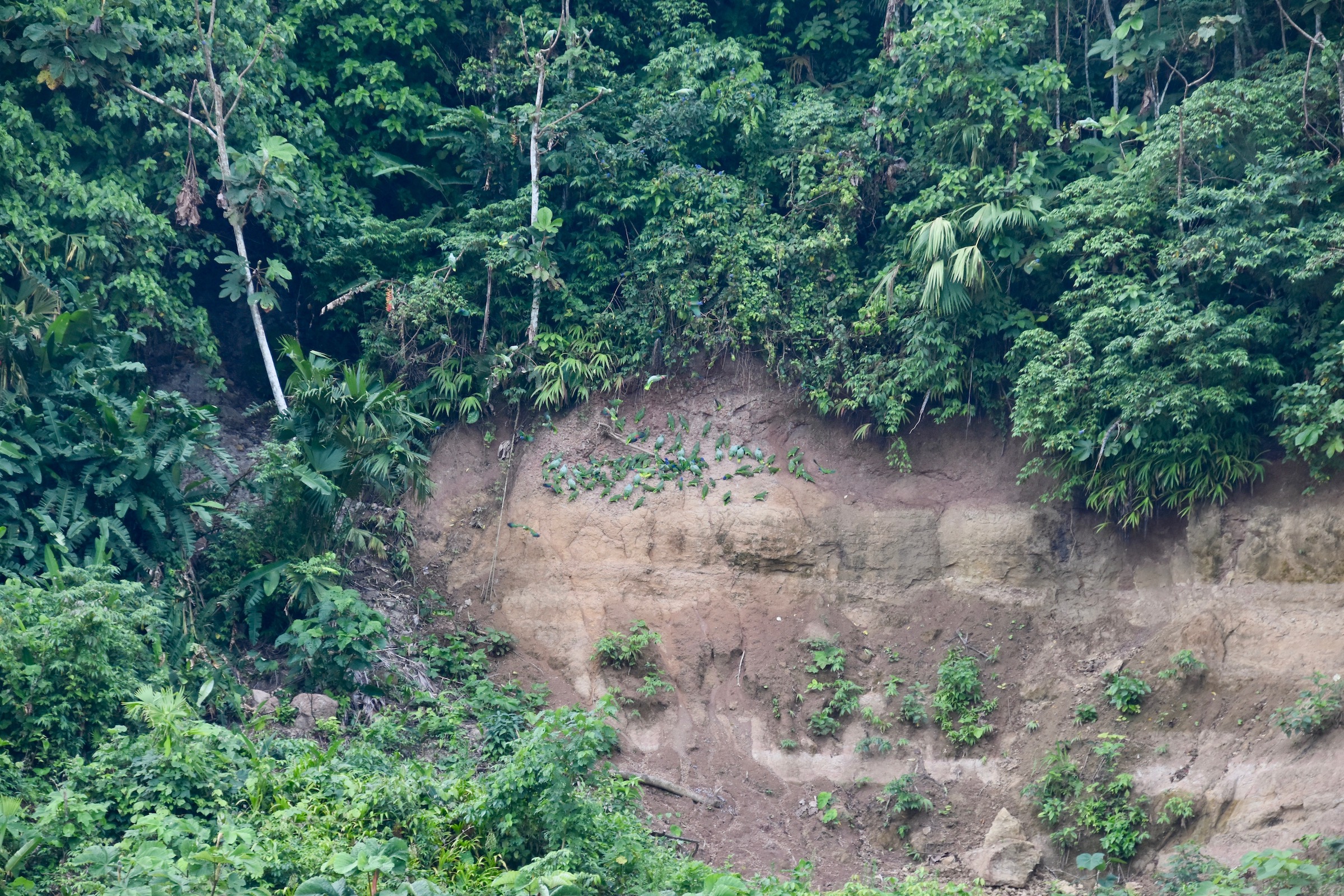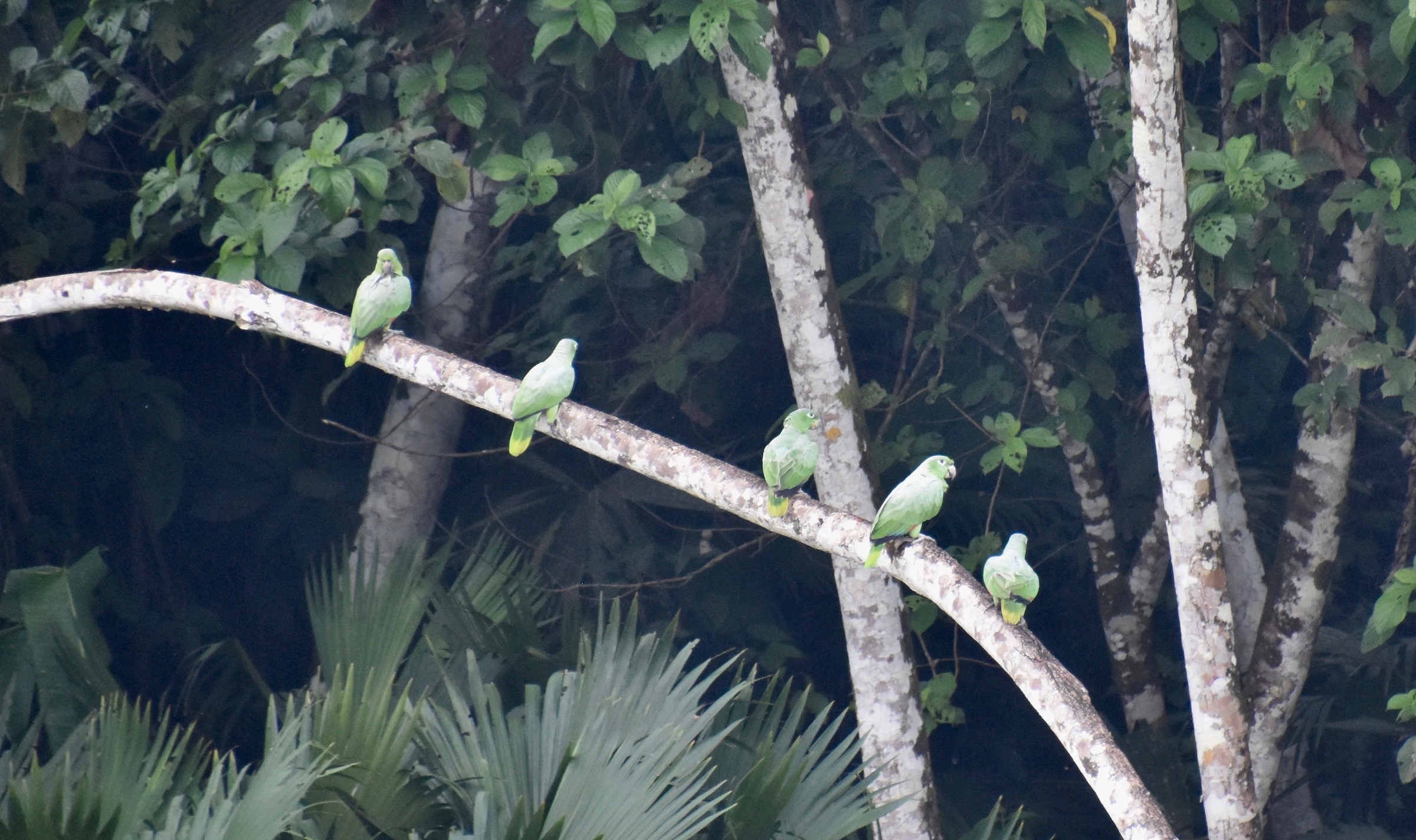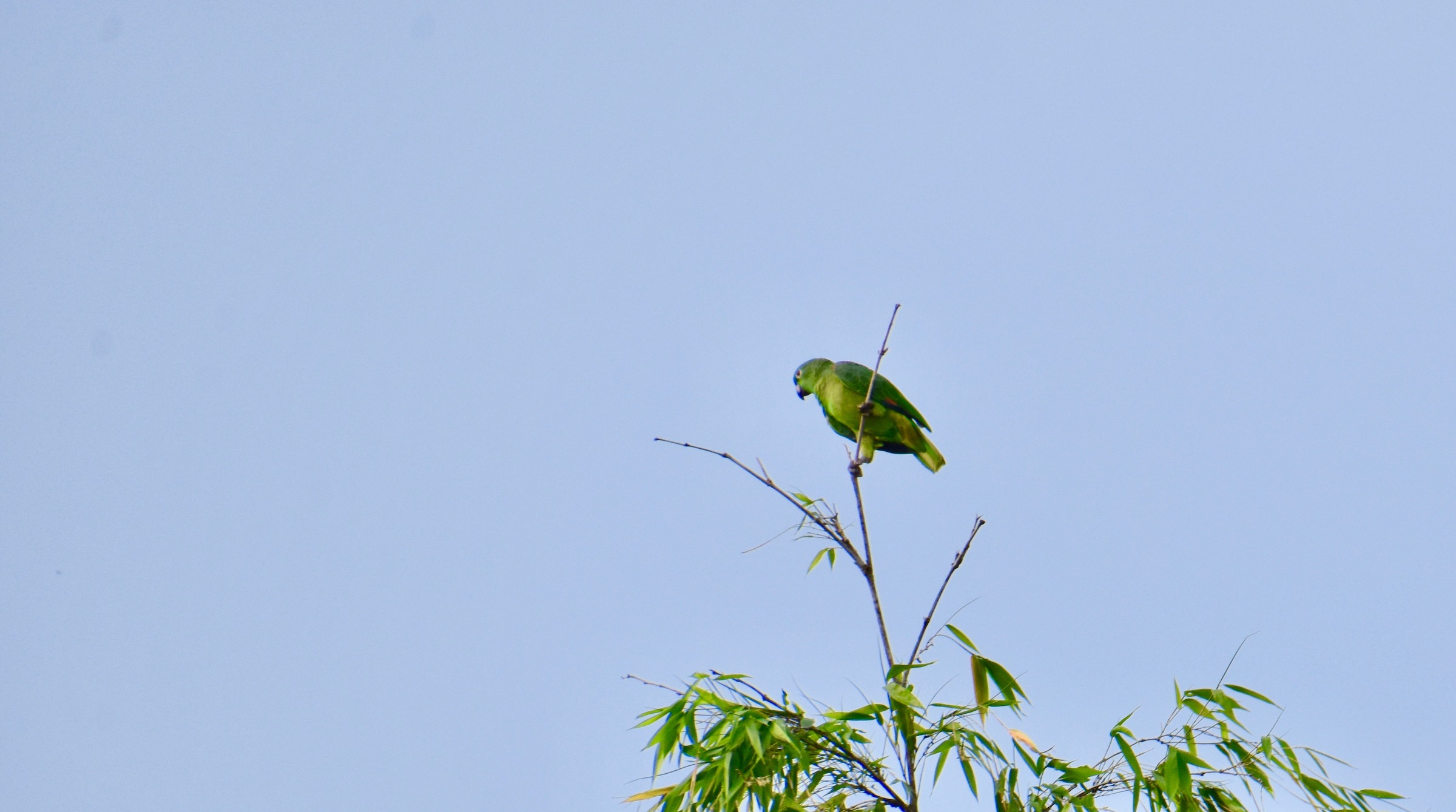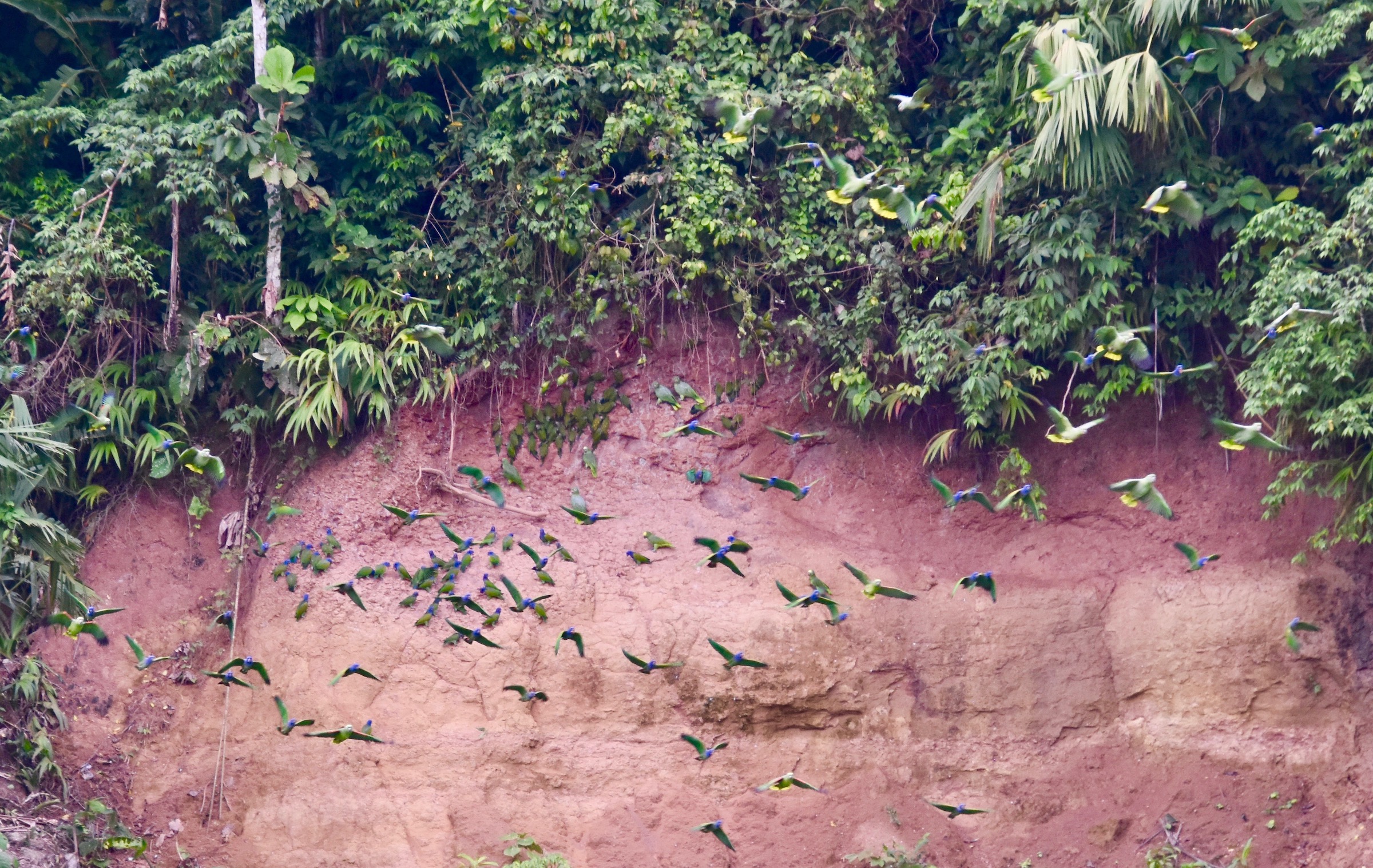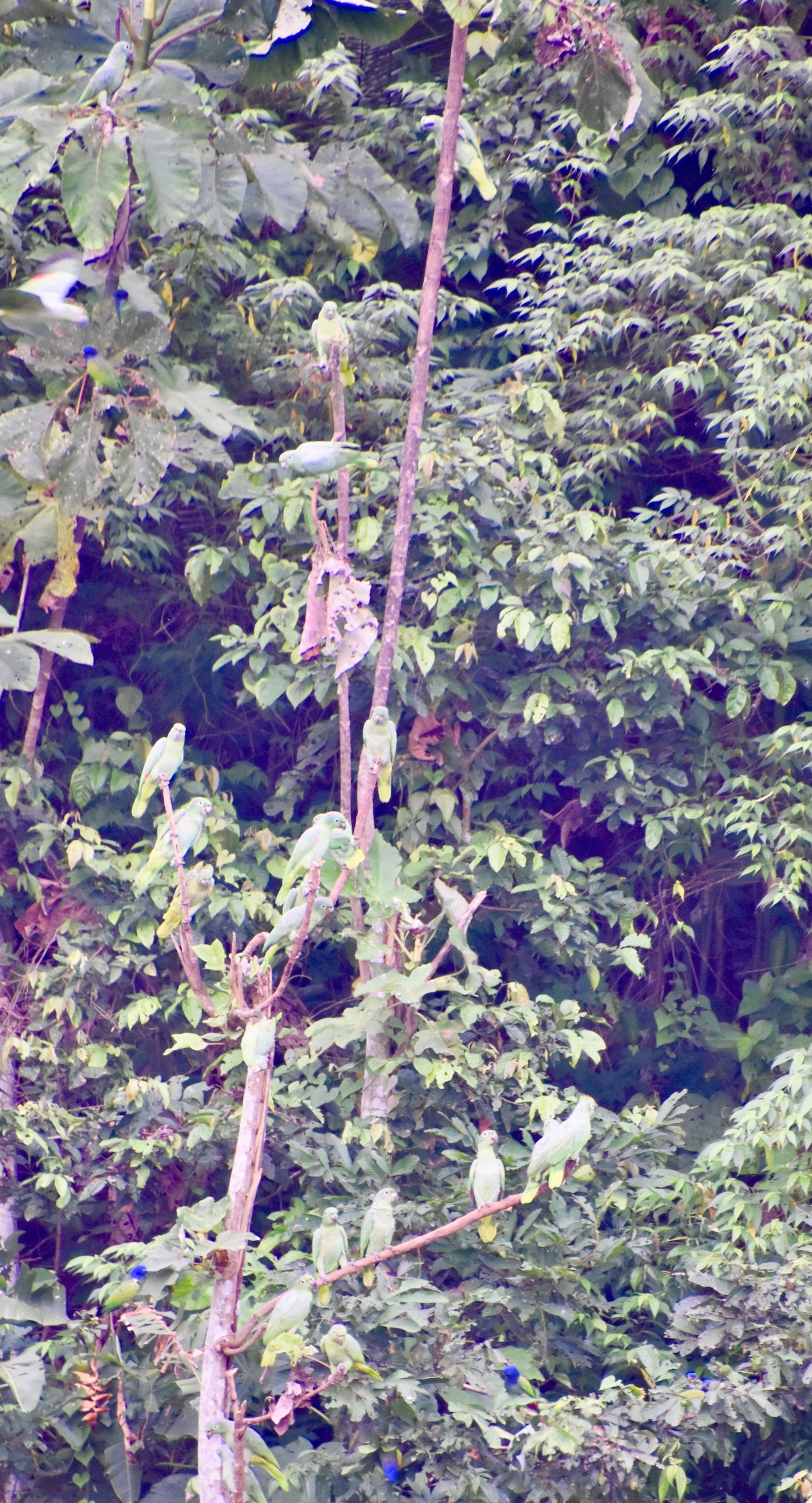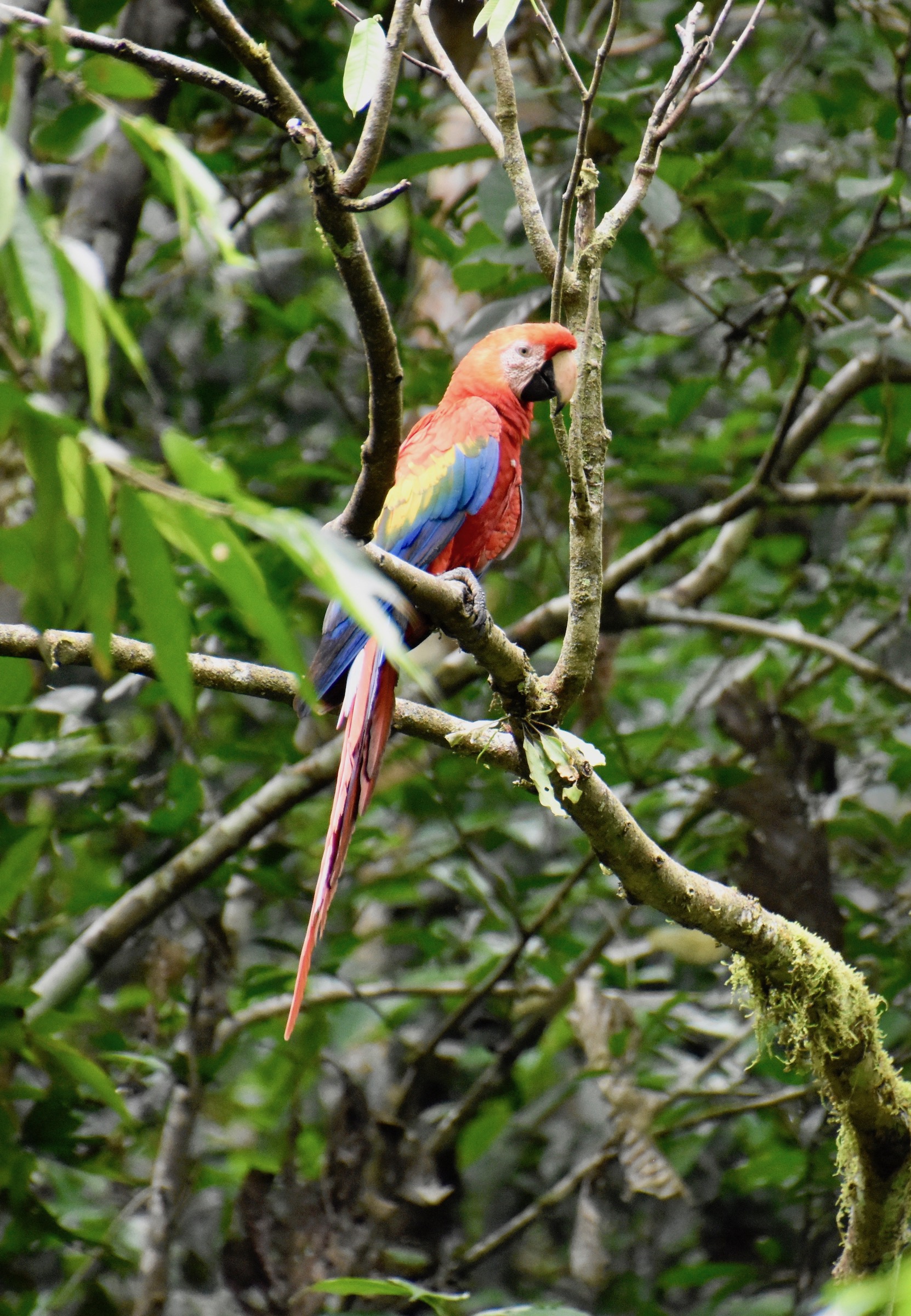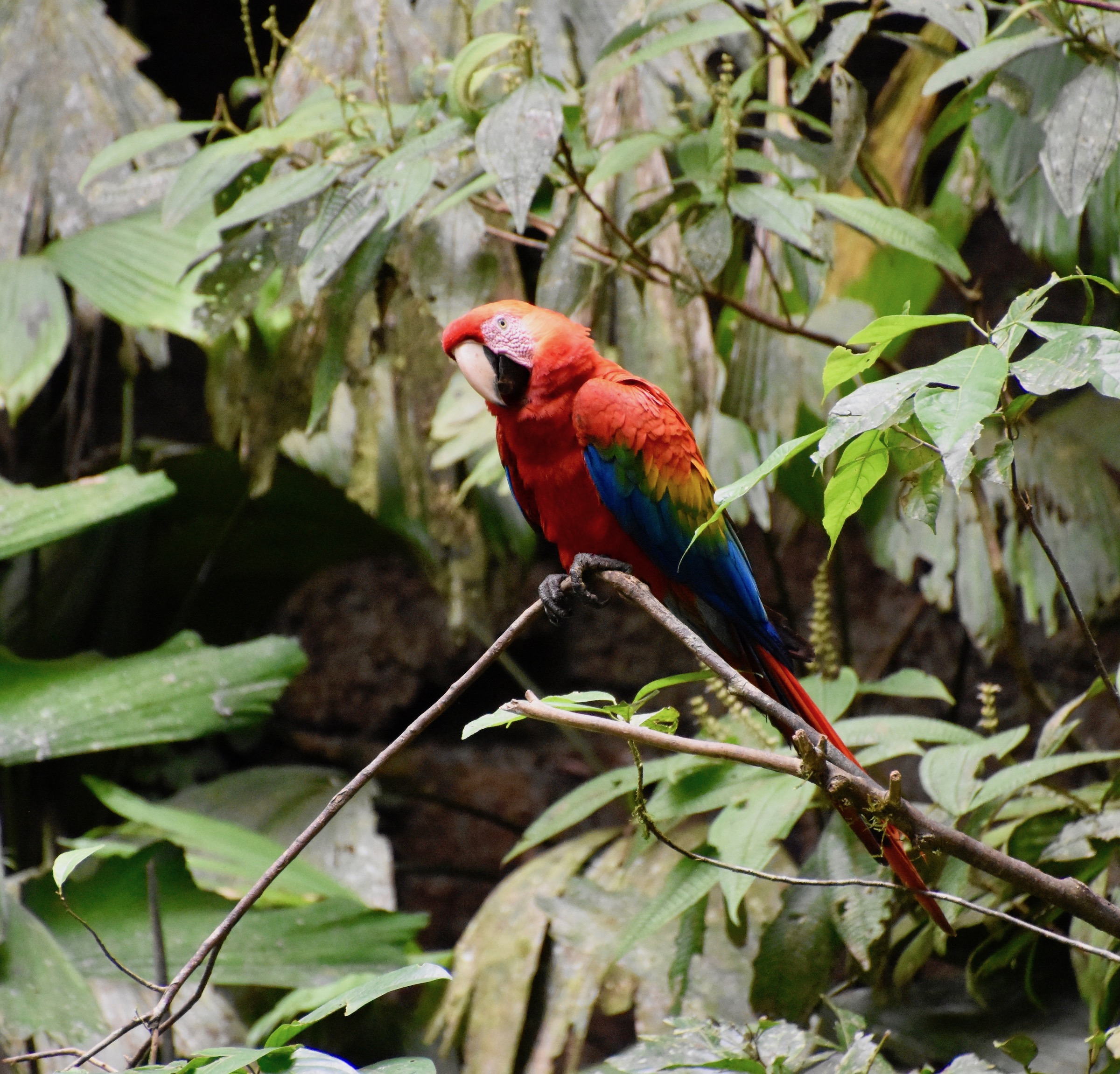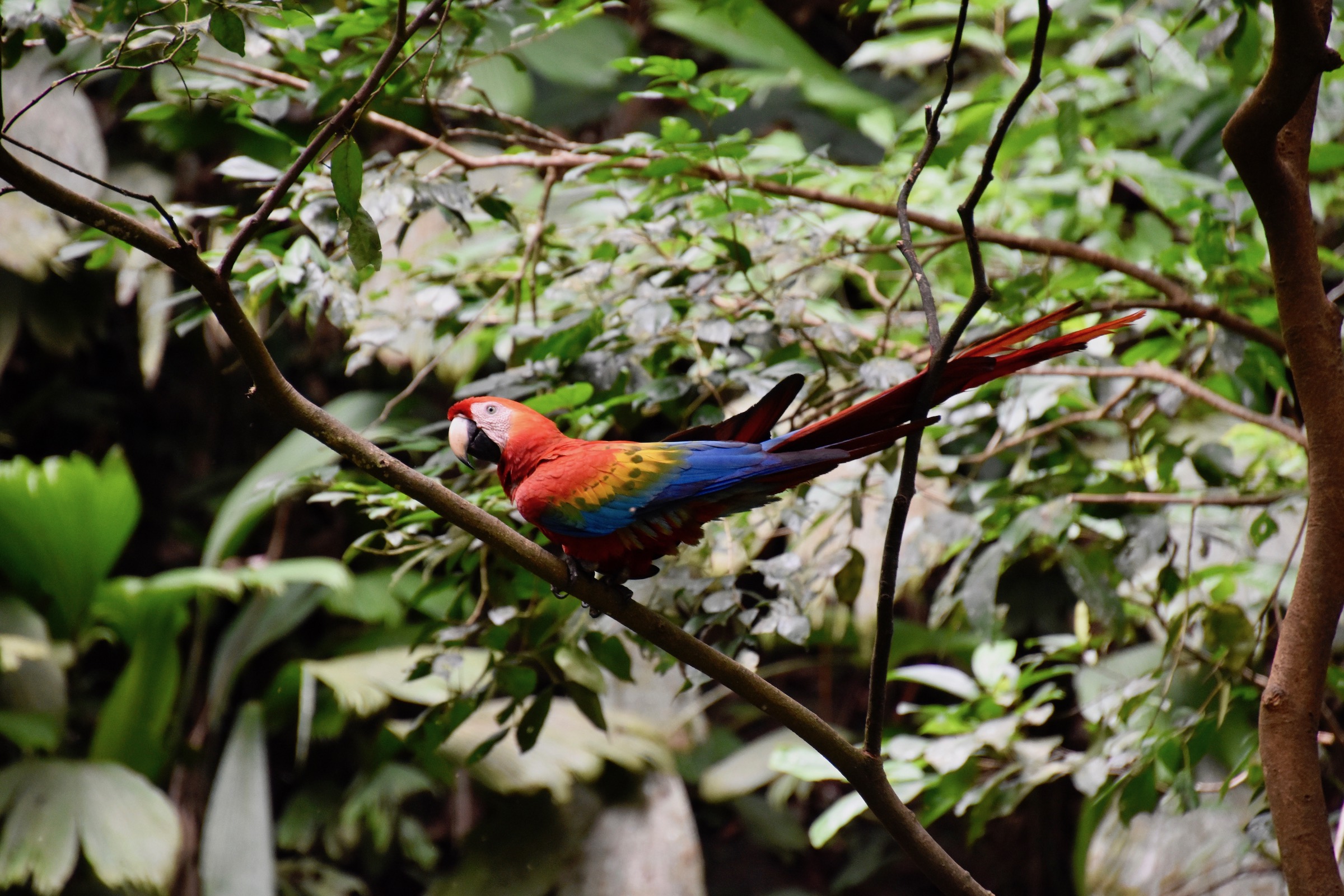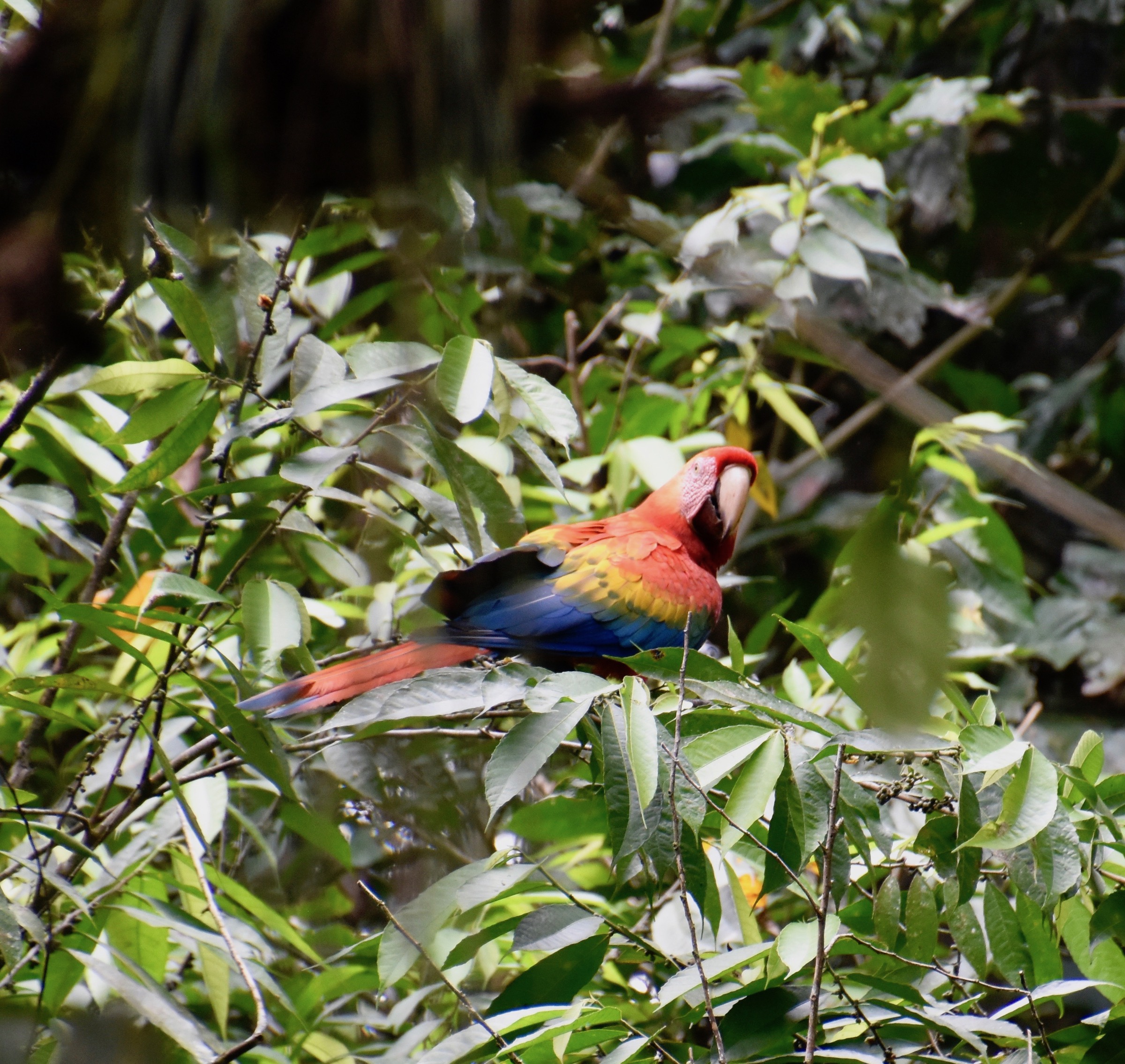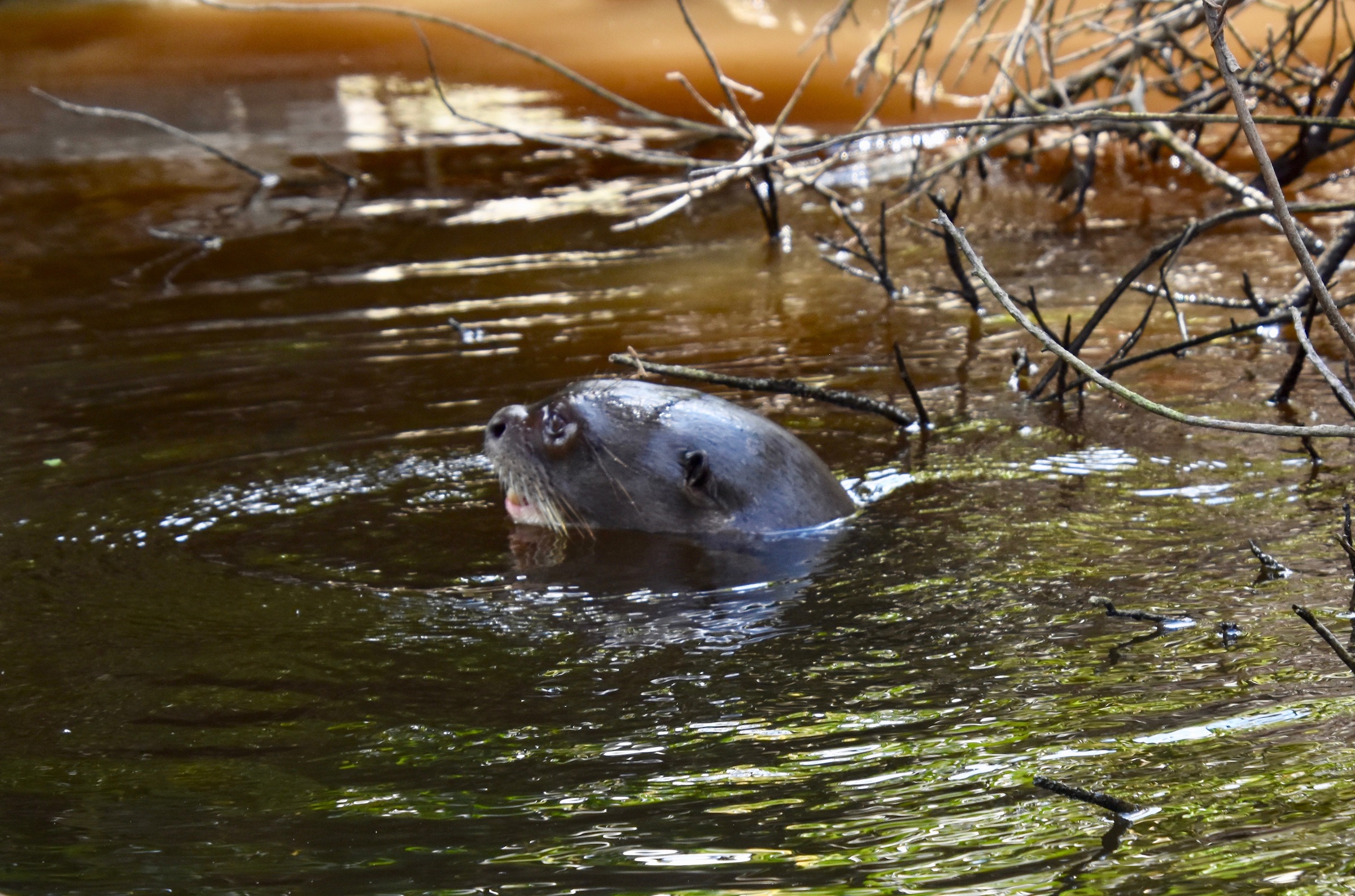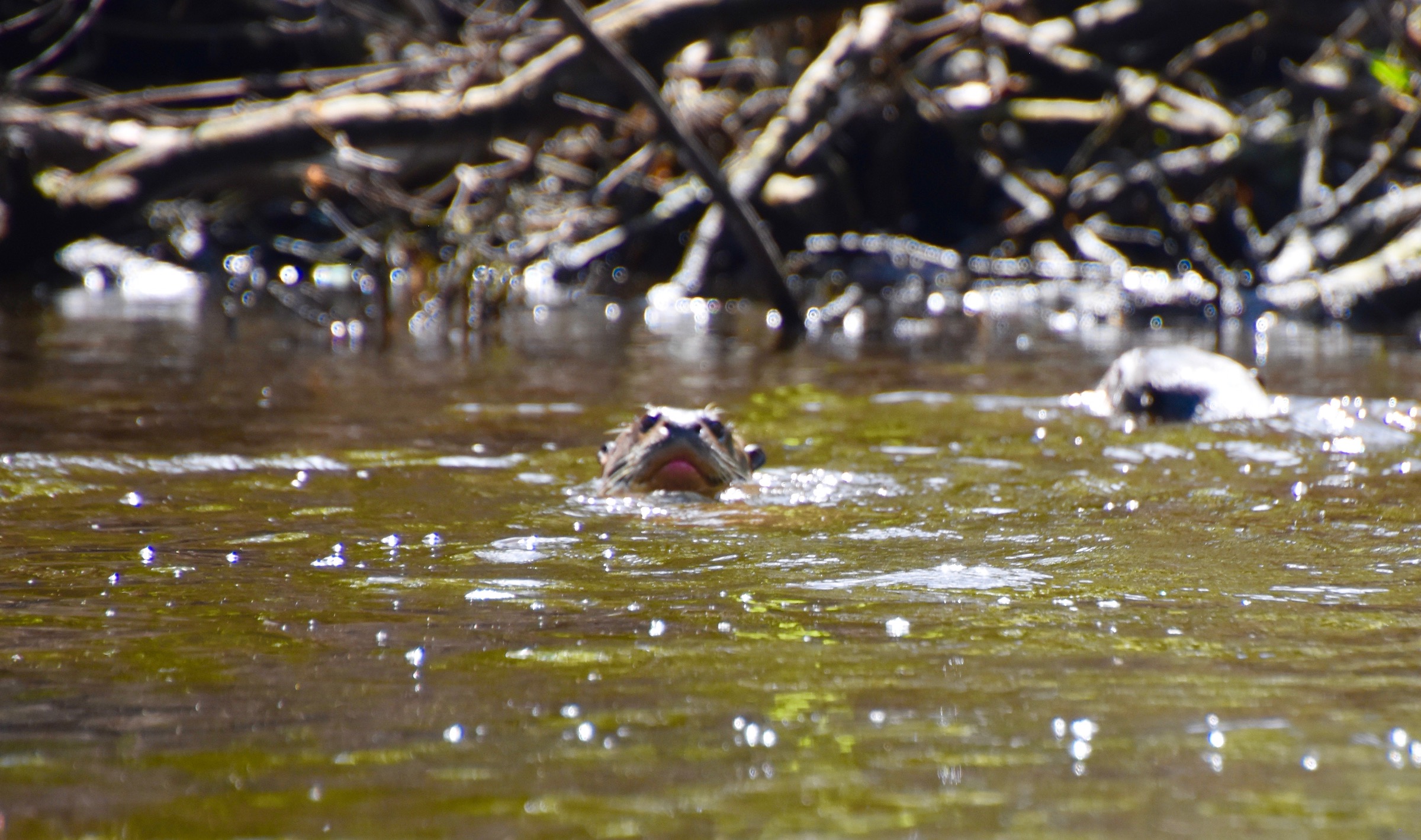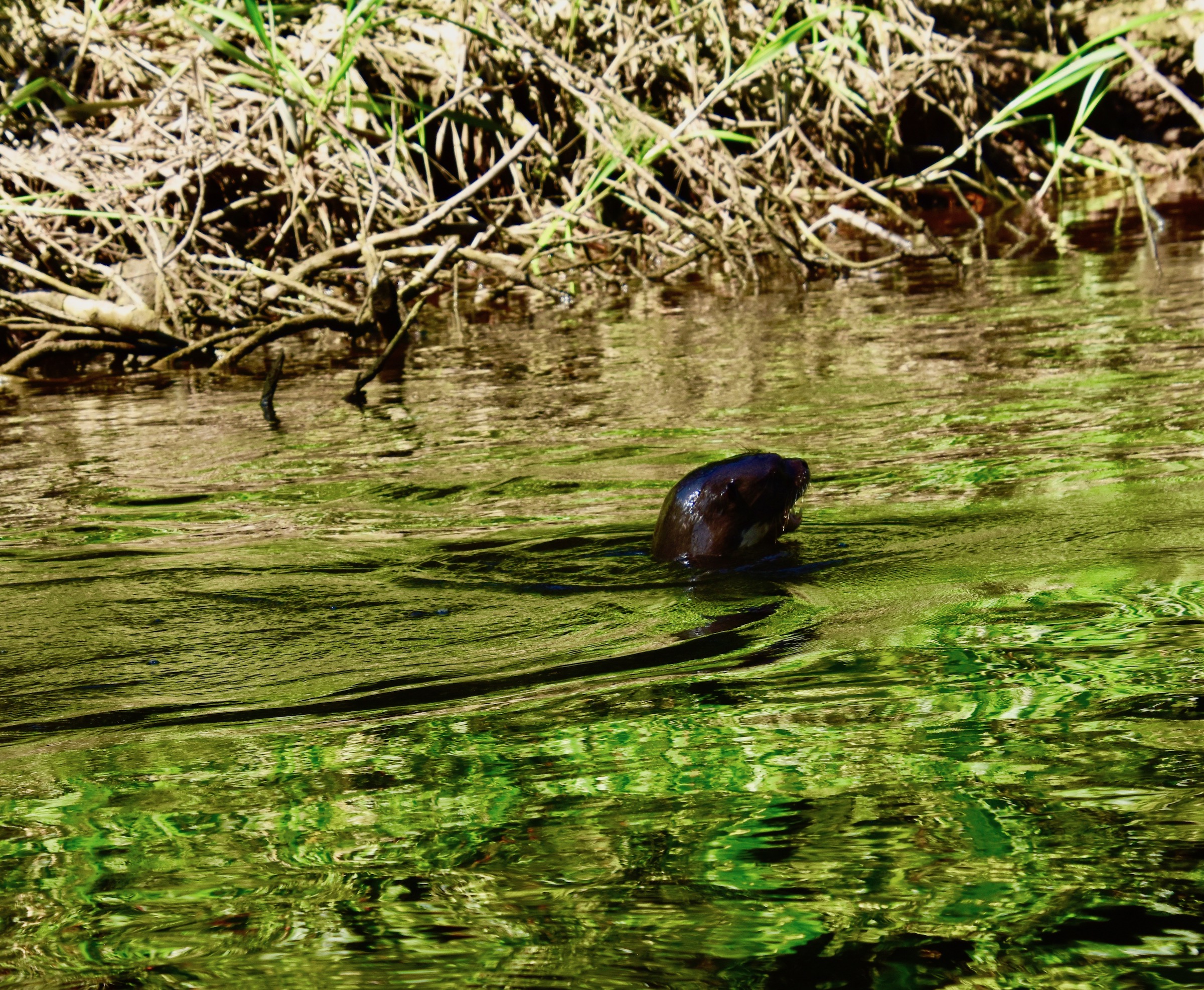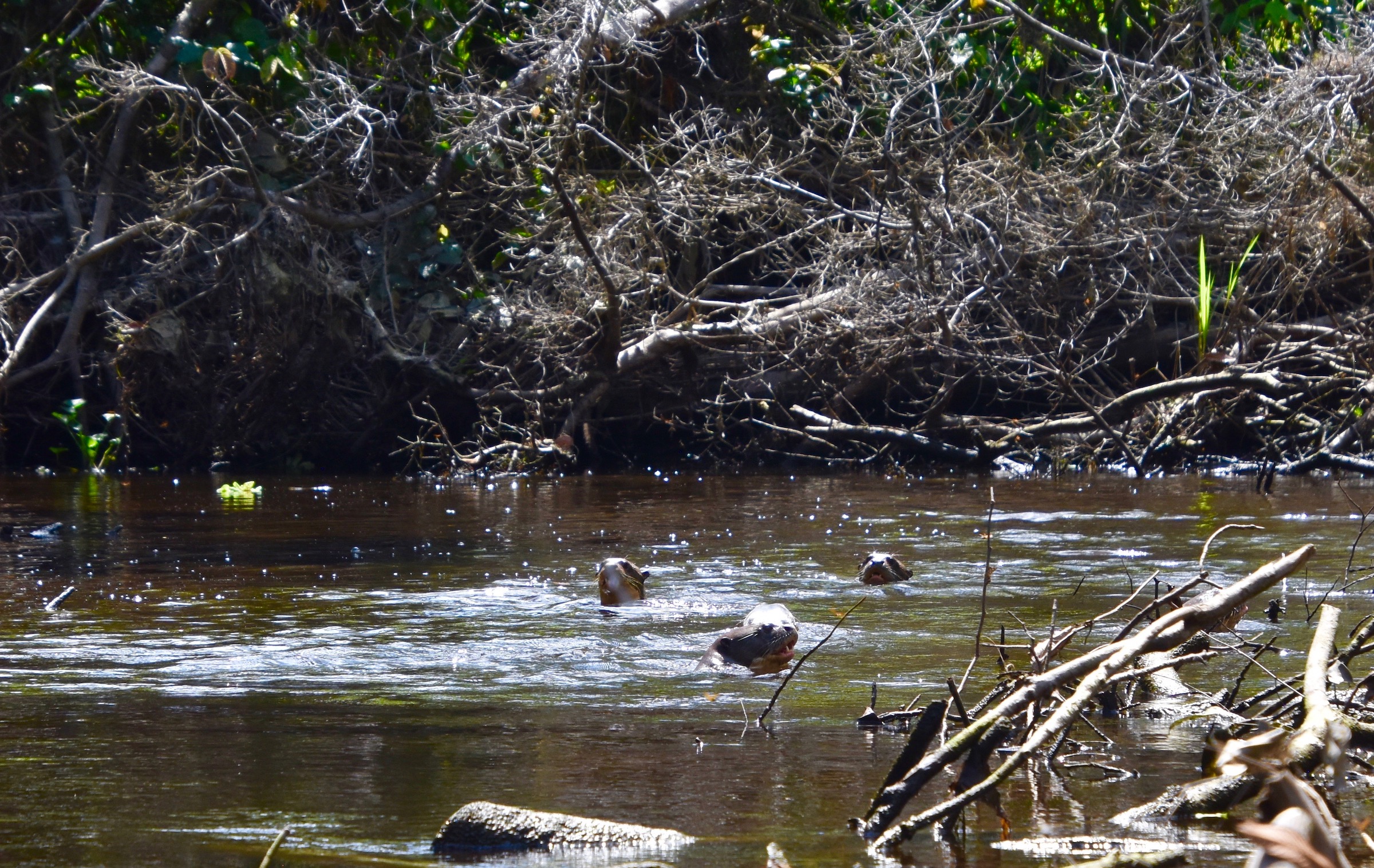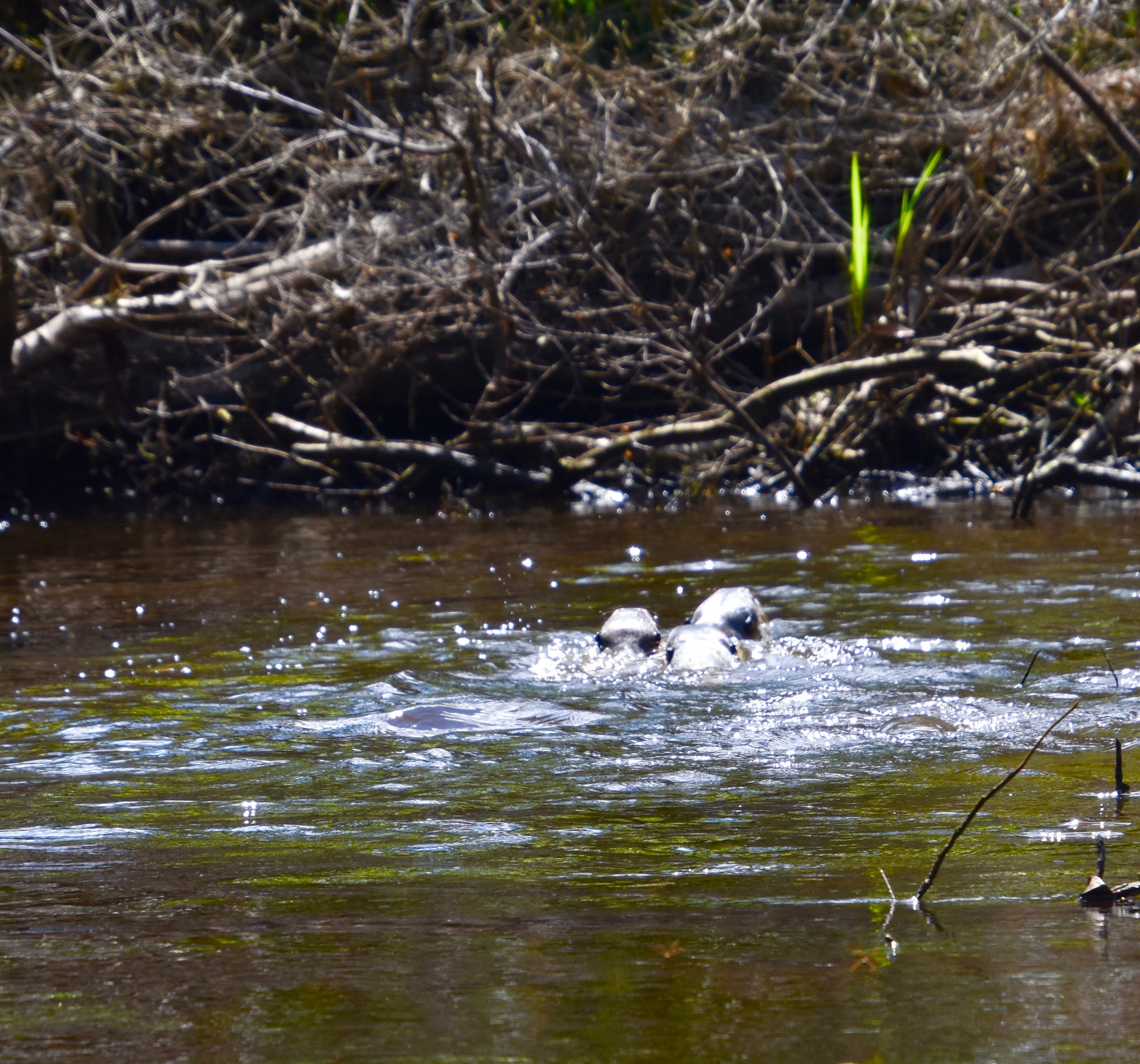Napo Cultural Center – Exploring Amazonia
In my last post from this Adventures Abroad tour of Ecuador we flew from the Galapagos to the city of Coca via Quito and then travelled down the Napo River to the Napo Cultural Center where we will spend three days. In this post I will give the highlights of that stay which including multiple wildlife viewing sessions both on foot and by boat. The center is located in Yasuni National Park which has arguably the greatest biodiversity per square metre of any place on the planet. It is also a UNESCO Biosphere Reserve which recognizes that 99.73% of its vegetation is original native forest. If you are concerned about deforestation of the Amazon region and want to see what the a true tropical rain forest looks like, then you can come to no better place than the Napo Cultural Center to witness and experience it first hand. With that brief introduction, let’s start exploring Amazonia.
The Two Towers
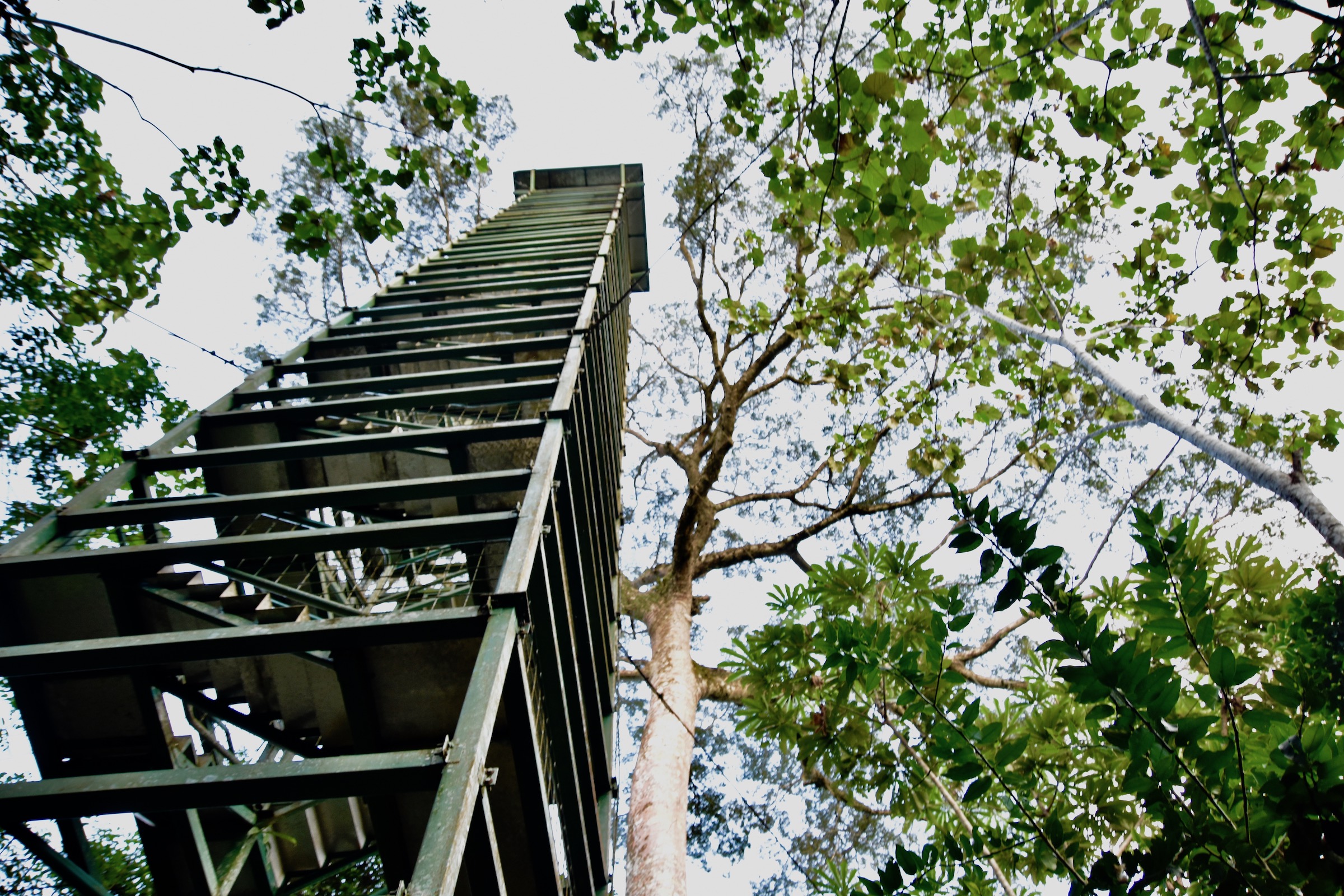
No, I’m not talking about the second book in Lord of the Rings, but rather two very high towers that the Napo Cultural Center has built to give guests not only fantastic views of the Amazon rain forest from the top of the tree line, but also to observe the wildlife that exists in the canopy. One tower is an easy walk from the center and that will be our first stop. Although there are other guests at the center our Adventures Abroad group has its own guide, Sergio who is an Indigenous Kichwa who has been guiding here for many years. His knowledge of the local flora and fauna is phenomenal.
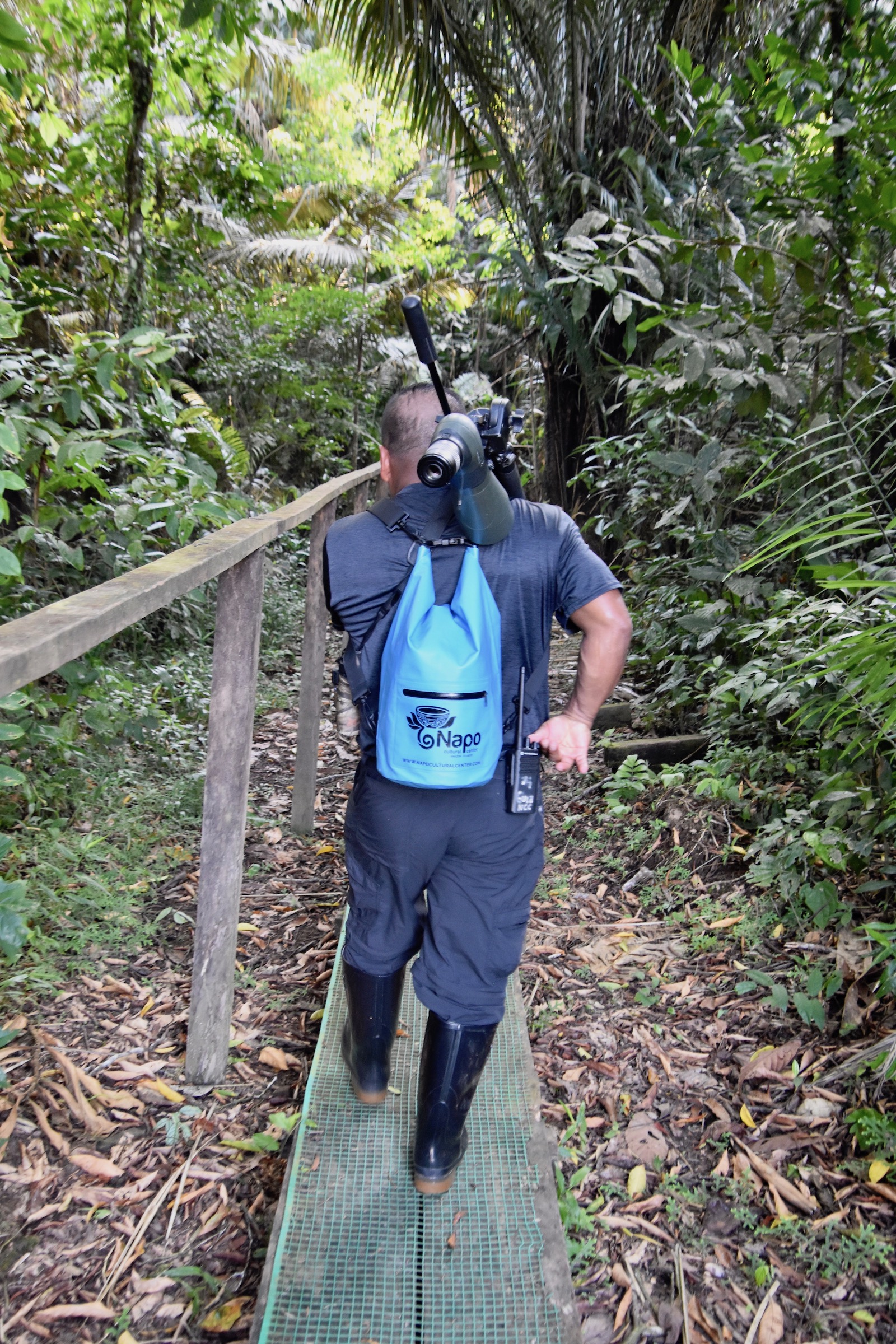
You might notice he is wearing rubber boots. We were all fitted with our own pair for the duration of the stay and although we encountered muddy sections of trail only a few times, they were definitely helpful when getting in and out of the boats.
Another thing I should note. People often associate tropical rain forests with plagues of biting and stinging insects. Well, I don’t know if we were just lucky or not, but they simply were not a problem at the Napo Cultural Center. I got more bites in a few hours working in my Nova Scotia garden than I did in three days here.
The tower nearest the center is built around a giant kapok tree that is well over 130 feet high, so it will be like climbing the stairs to the top of a 13 story building.
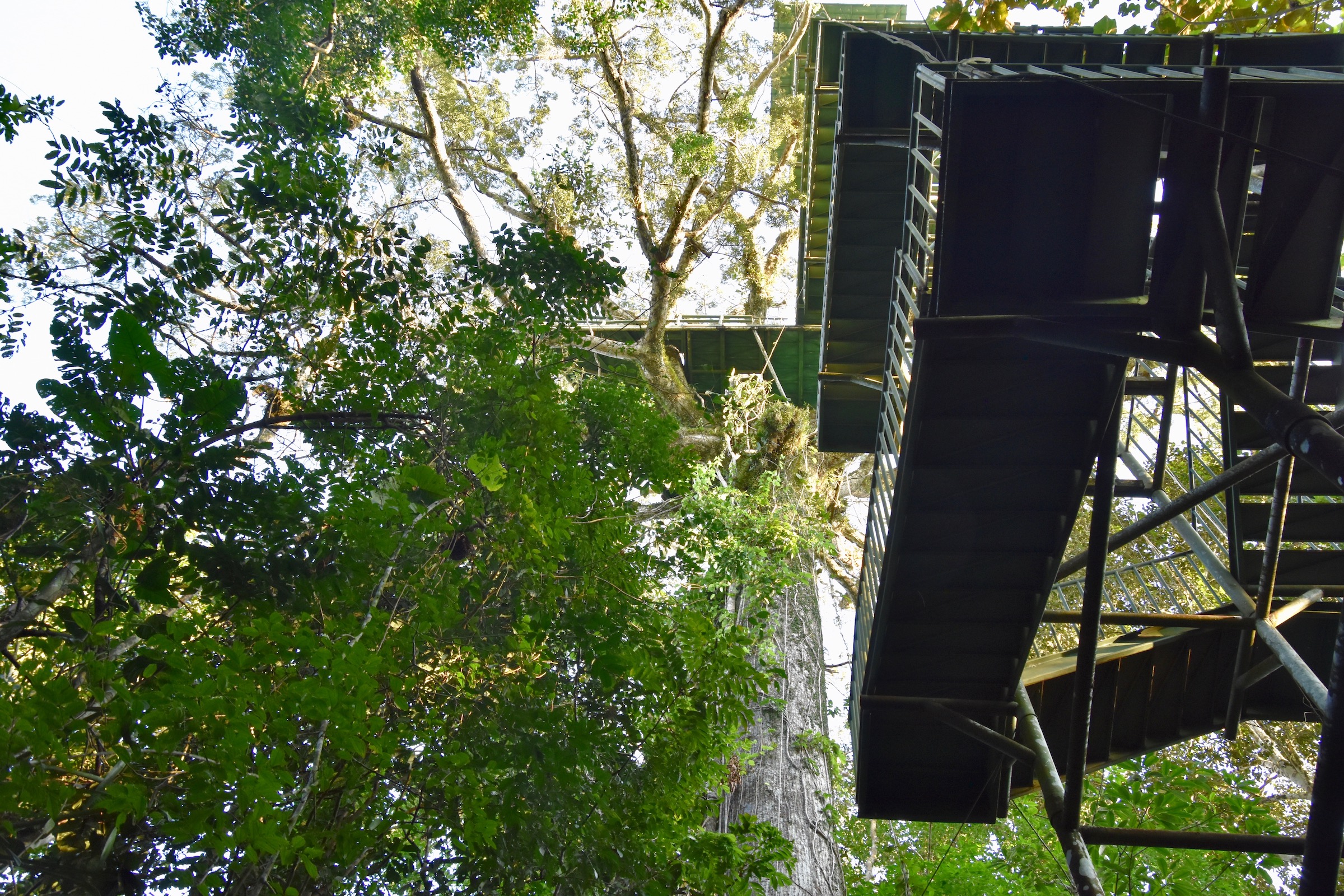
There is a viewing platform at about 100 feet and another at the very top. Here I am looking down at the rest of the group on the first platform.
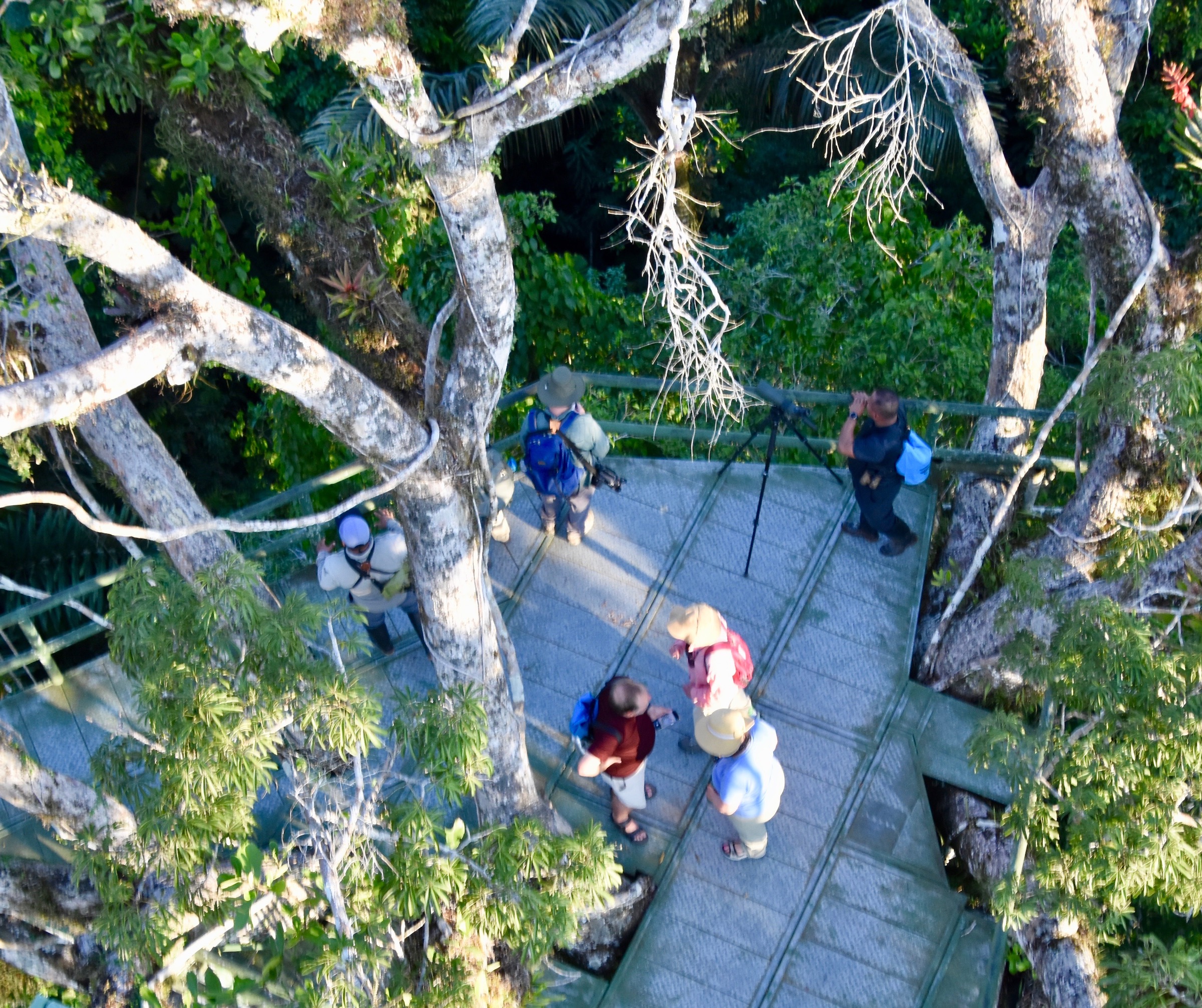
You might be a bit winded by the time you get to the top, but it’s more than worth it for the view as you look down at the rainforest canopy below. You also realize how much taller this kapok tree is than the vegetation around it.
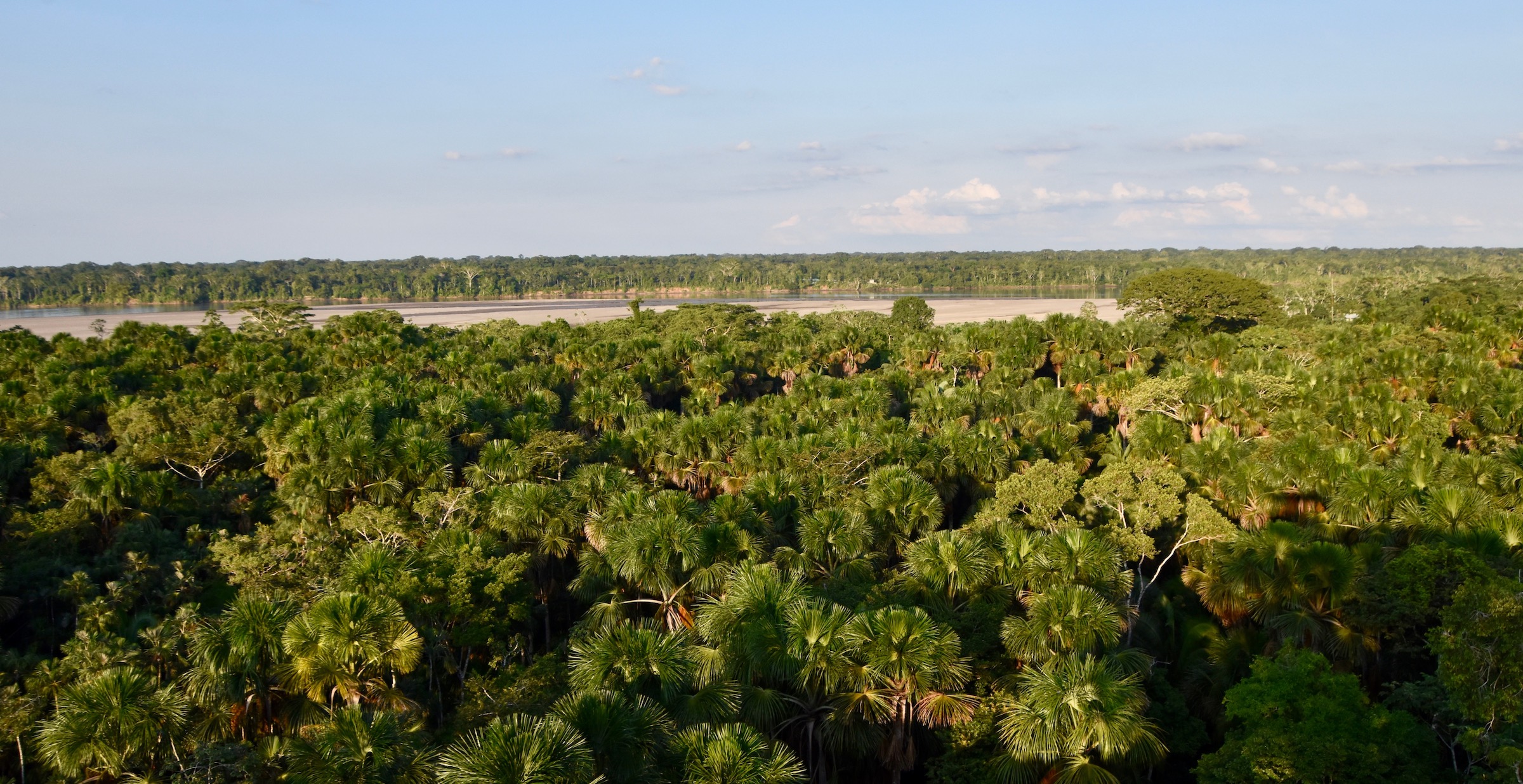
Sergio sets up the spotting scope and trains it on a white-necked puffbird, a life lister for me.
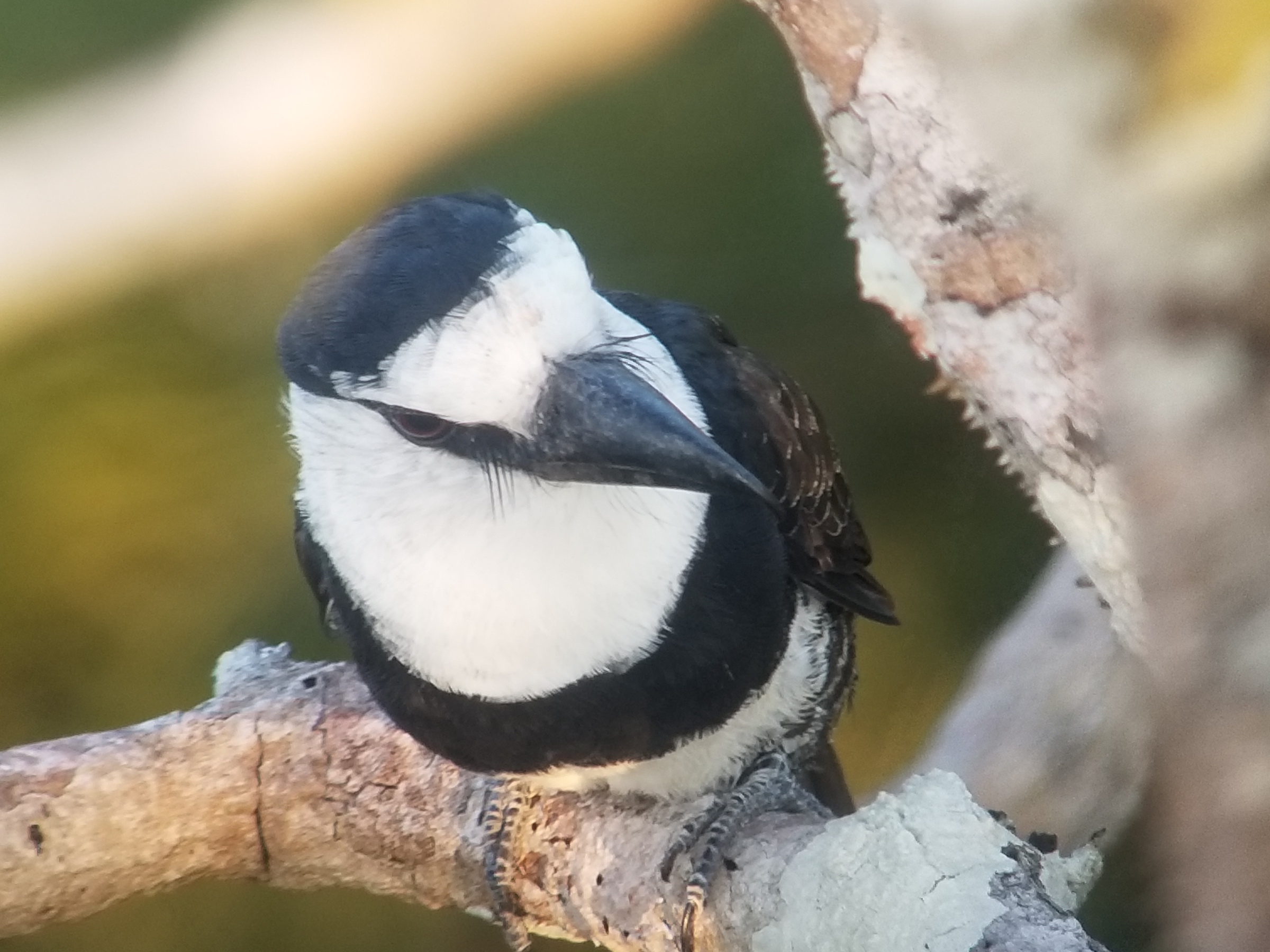
Although this photo makes it look like the bird was very close by, it was actually over 100 feet away. With the aid of the spotting scope and smart phone cameras that can take shots through the spotting scope lens you can get great close up photos. I first learned of this technique in Africa a few years ago and the guides at the Napo Cultural Center are very conversant with how to use it.
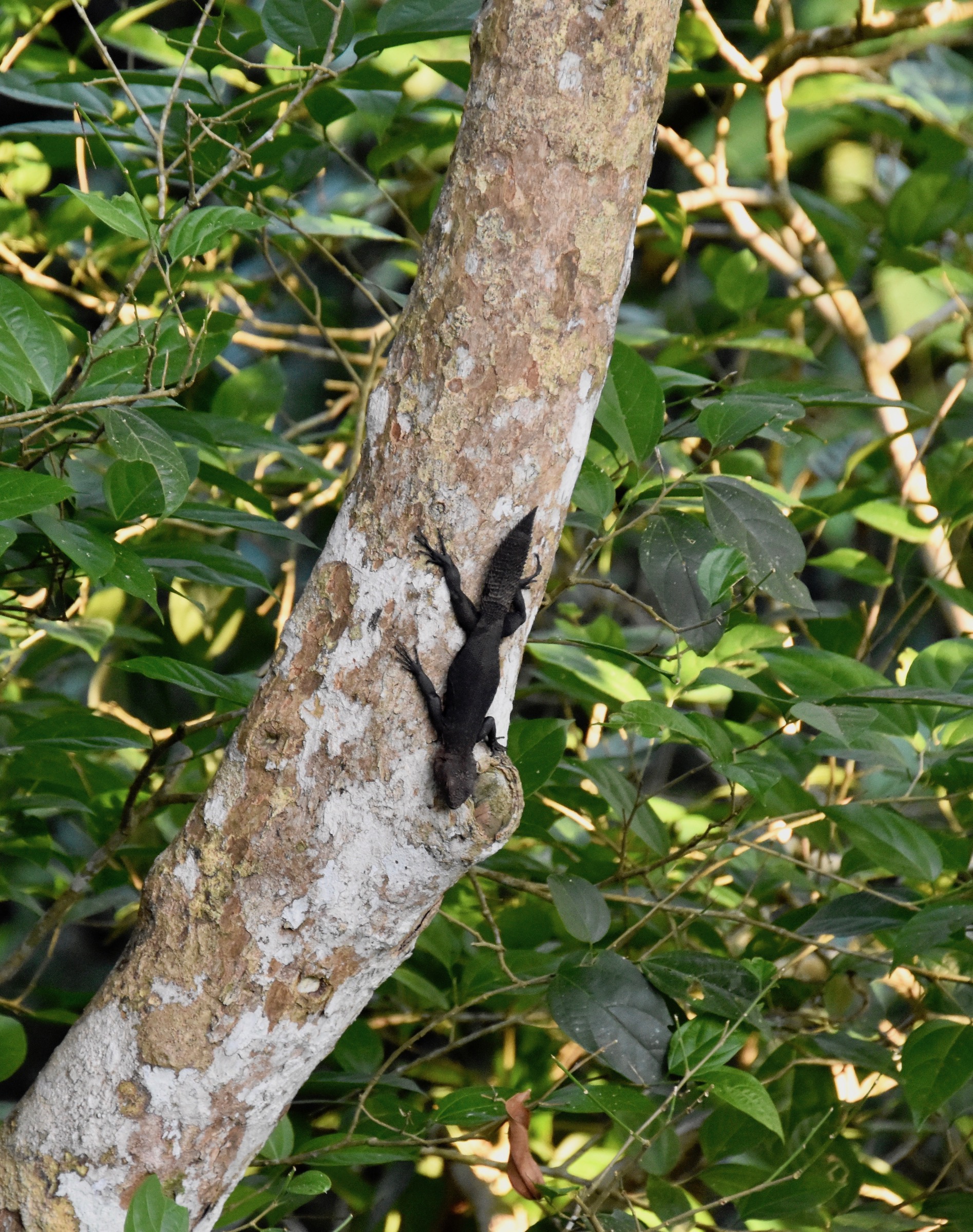
Much closer at hand was this Amazon thornytail iguana, another first for me. These lizards live their entire lives in the canopy feeding on the abundance of ants and other insects to be found here.
Speaking of ants, as we make our way back to the Napo Cultural Center Sergio points out a parade of leaf cutter ants that have to be the hardest working creatures in the insect world. They cut up leaves and haul them back to their ant colonies that can be huge. There’s one in Metropolitan Park in Panama City that is over an acre in size. Once inside the colony the leaves are infected by a fungus which in turn is the food of the ant’s larva. In effect they are bio-farmers.
They are fascinating to watch as you can see in the world’s shortest video taken on my phone by Sergio.
The second tower is somewhat downriver from the Napo Cultural Center and involves a walk of about a kilometre from the shoreline. This one is entirely free-standing like an old fire tower with stairs up rather than a ladder. Once again the view from the top is well worth the effort to get up there. This is Alison and Sergio with all of Amazonia in the background.
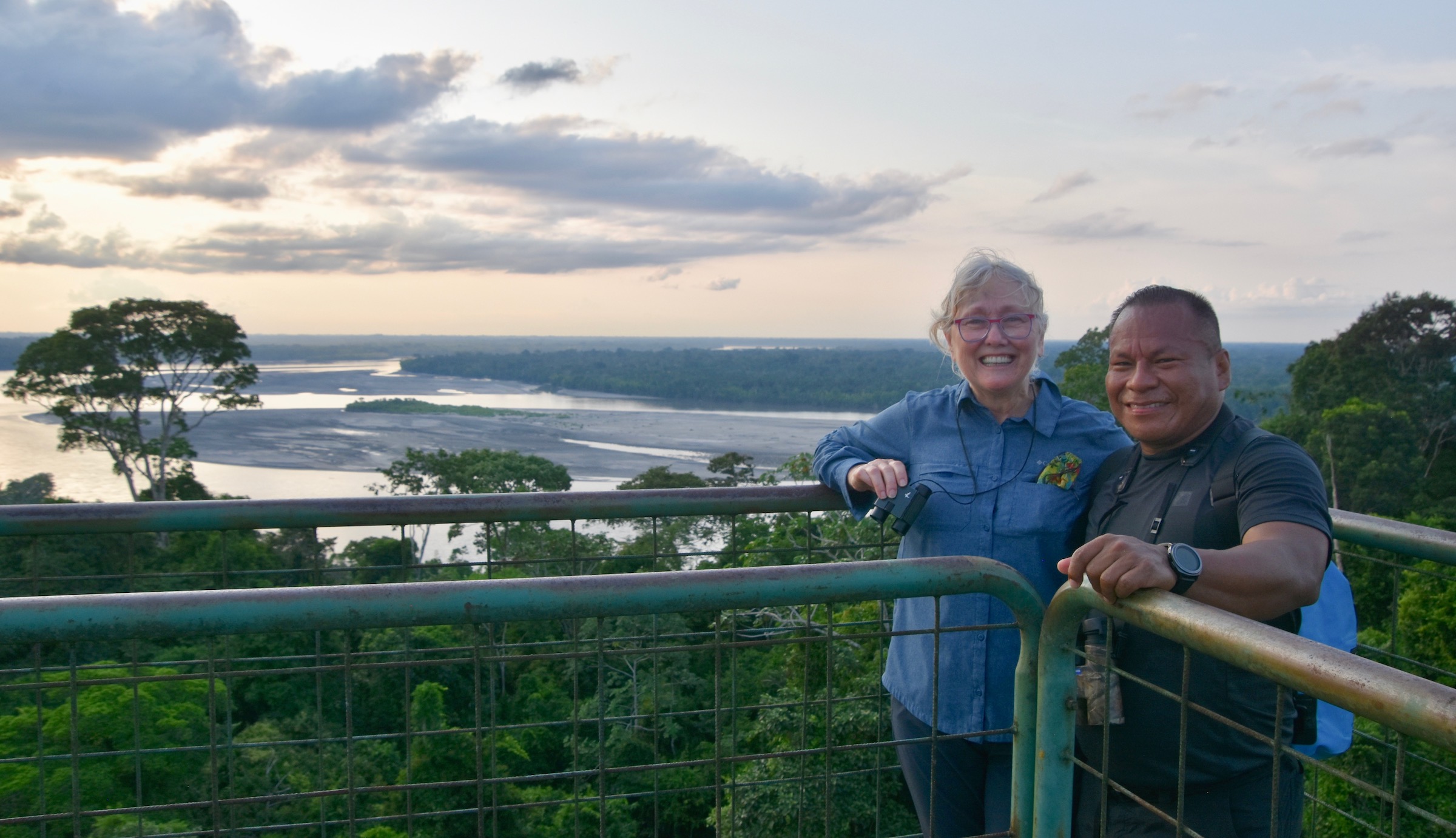
The wildlife viewing from the second tower is more productive than the first as we are alerted to the presence of howler monkeys by their, you guessed it, howls.
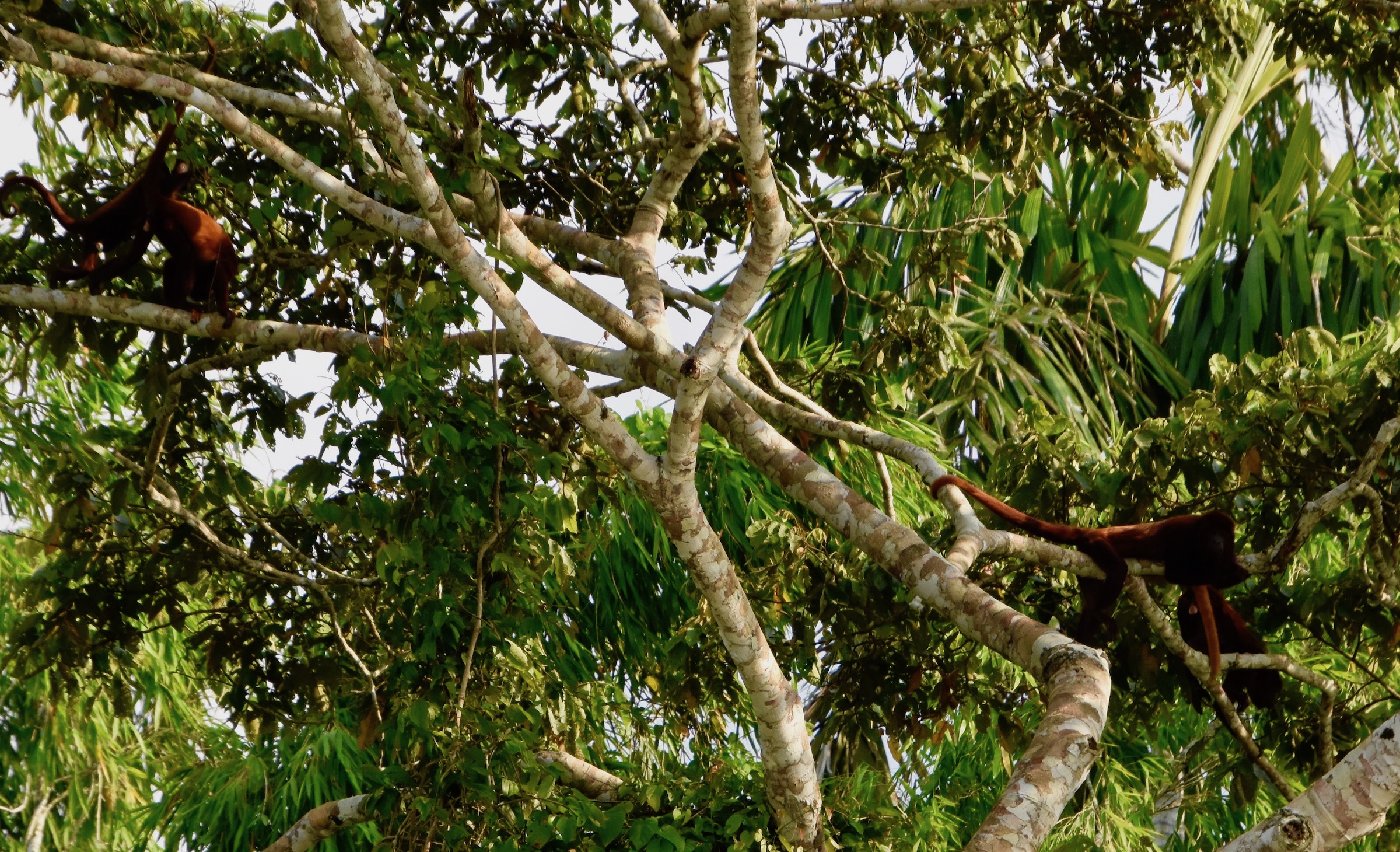
They are not the only monkeys we can see from the tower. With his sharp eyes Sergio spots a squirrel monkey in a nearby tree.
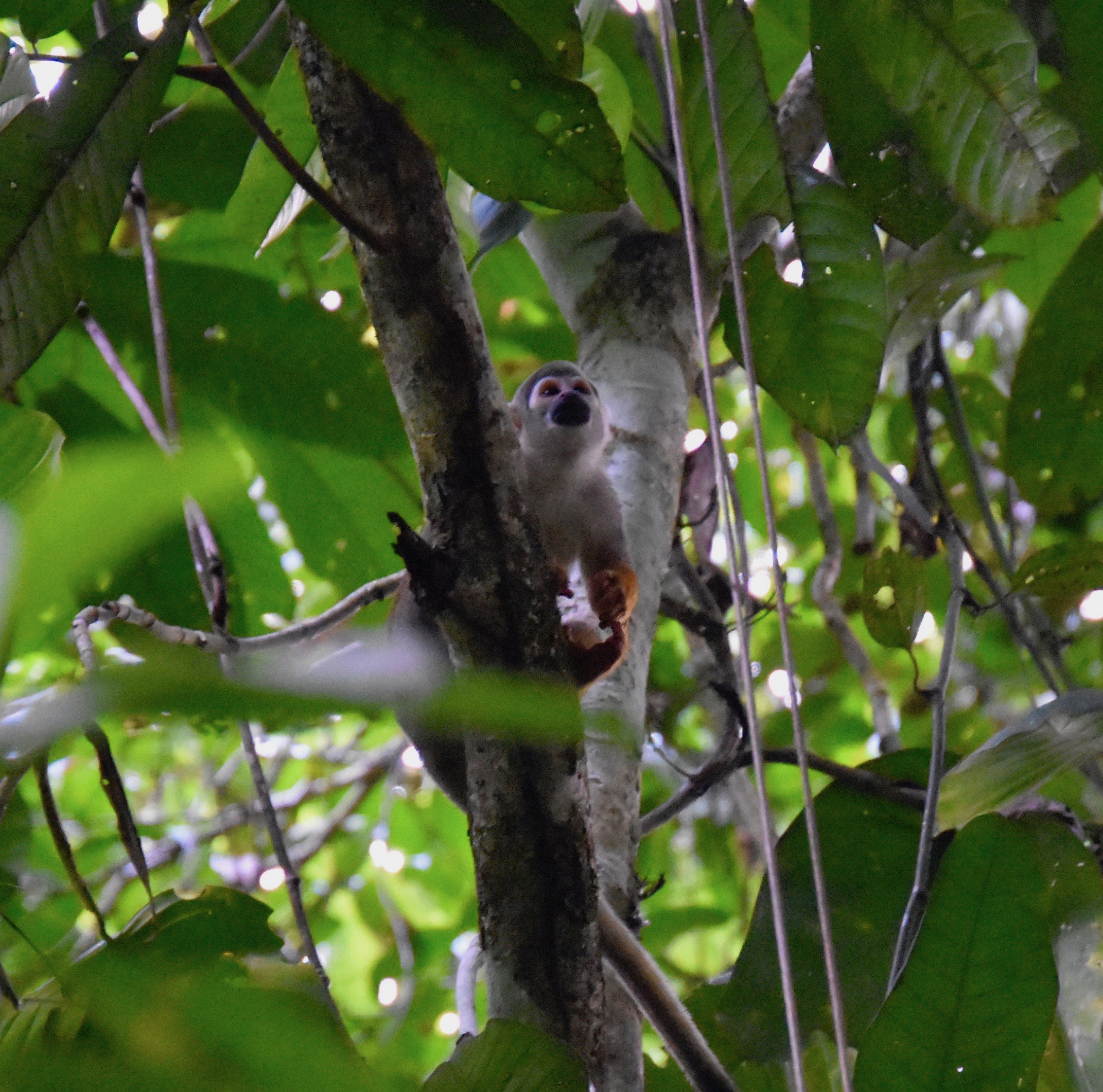
The birding is also quite good from up here and I get another life-lister with this striped toucan. It’s a beautiful looking bird.
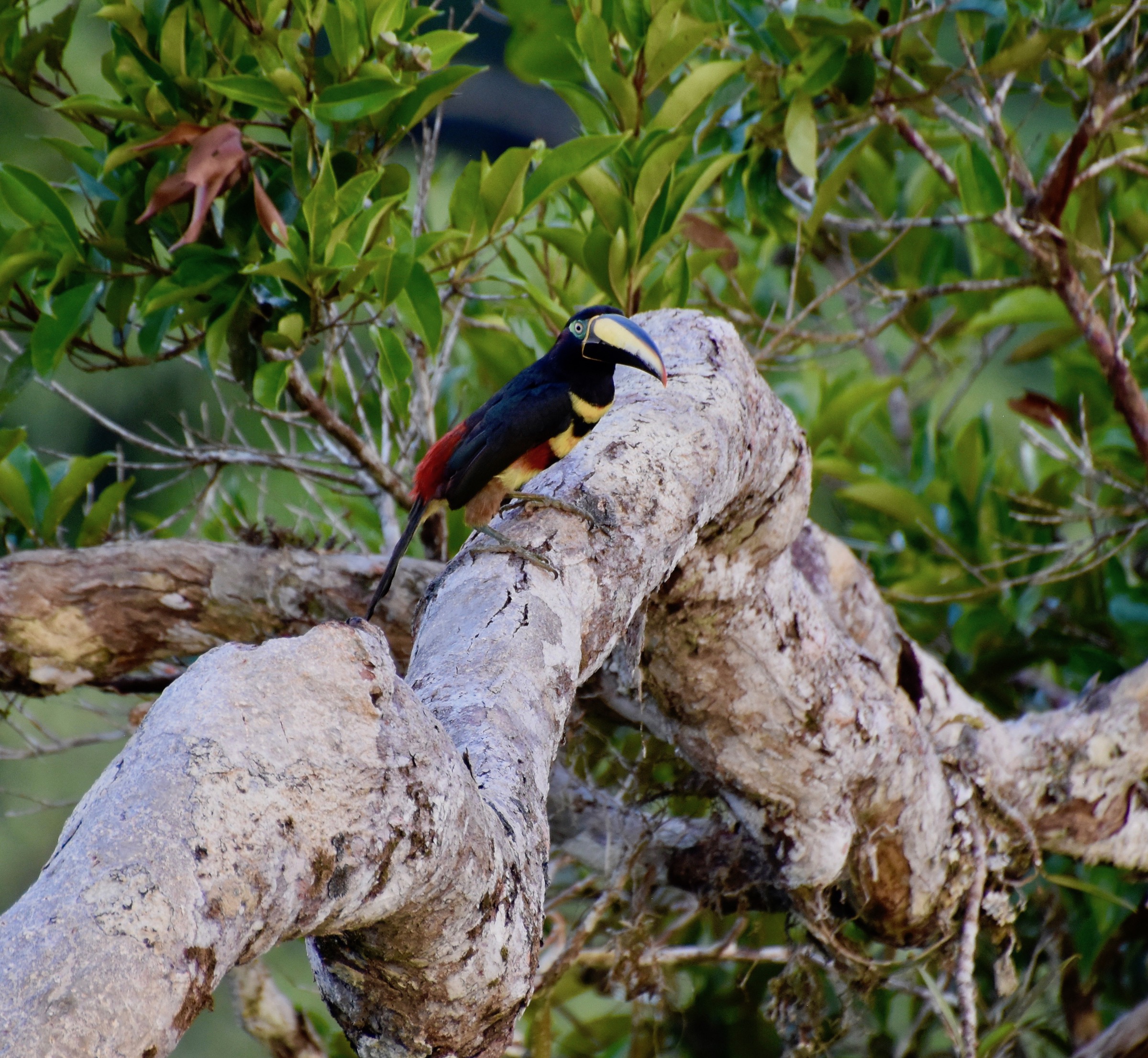
Not to be overlooked are the many insect species found in the canopy. This unidentified butterfly is also a beauty. Amazonia has so many species of insects that new ones are found almost every day and who knows if this is one or not?
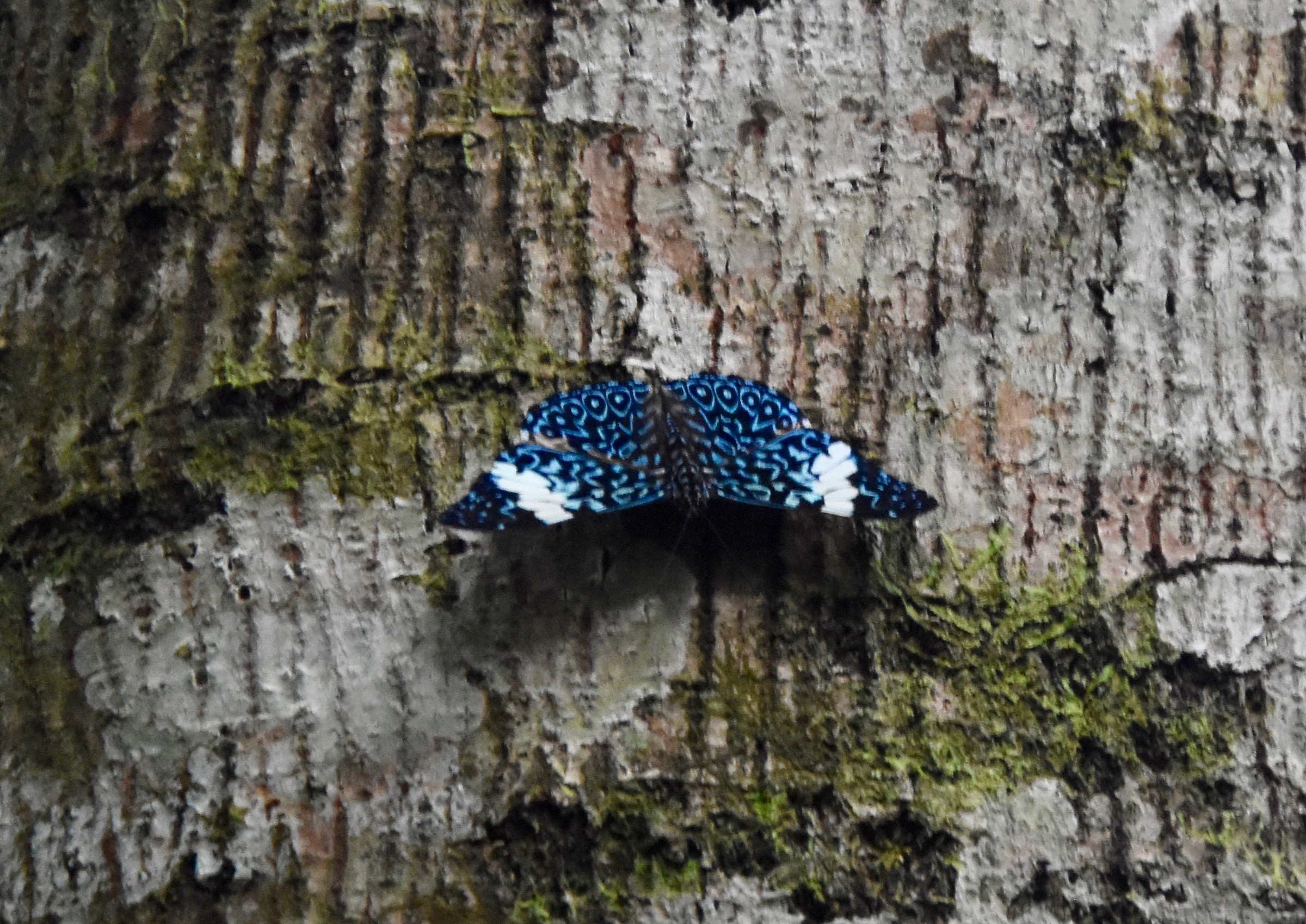
We are here at dusk and get back to the boat just as the sun is about to set.
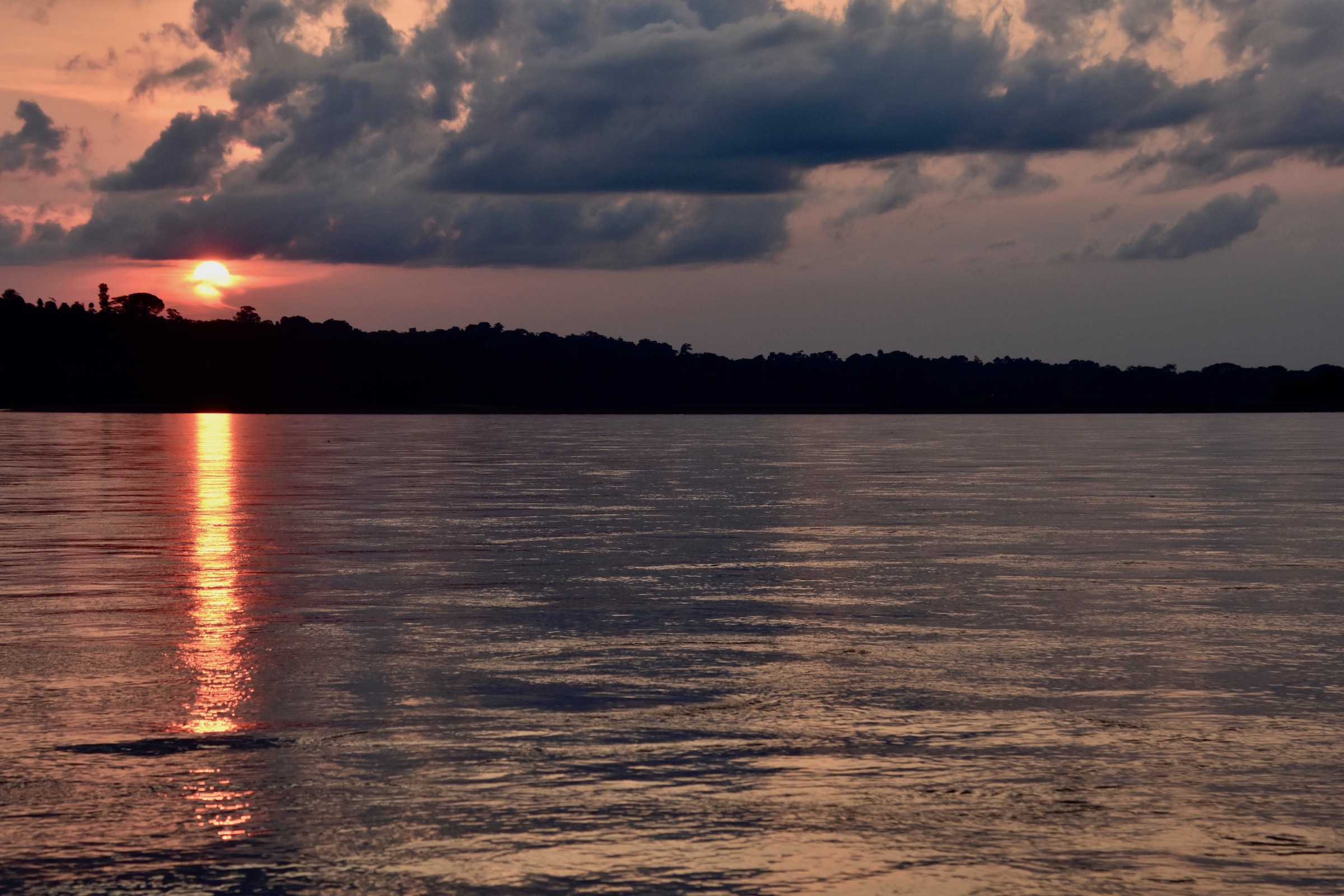
However, the wildlife viewing is not over for the day as Sergio leads us on a short night time walk around the perimeter of the Napo Cultural Center. The most interesting creature we come upon is this whip scorpion which looks fearsome, but is harmless to human beings.
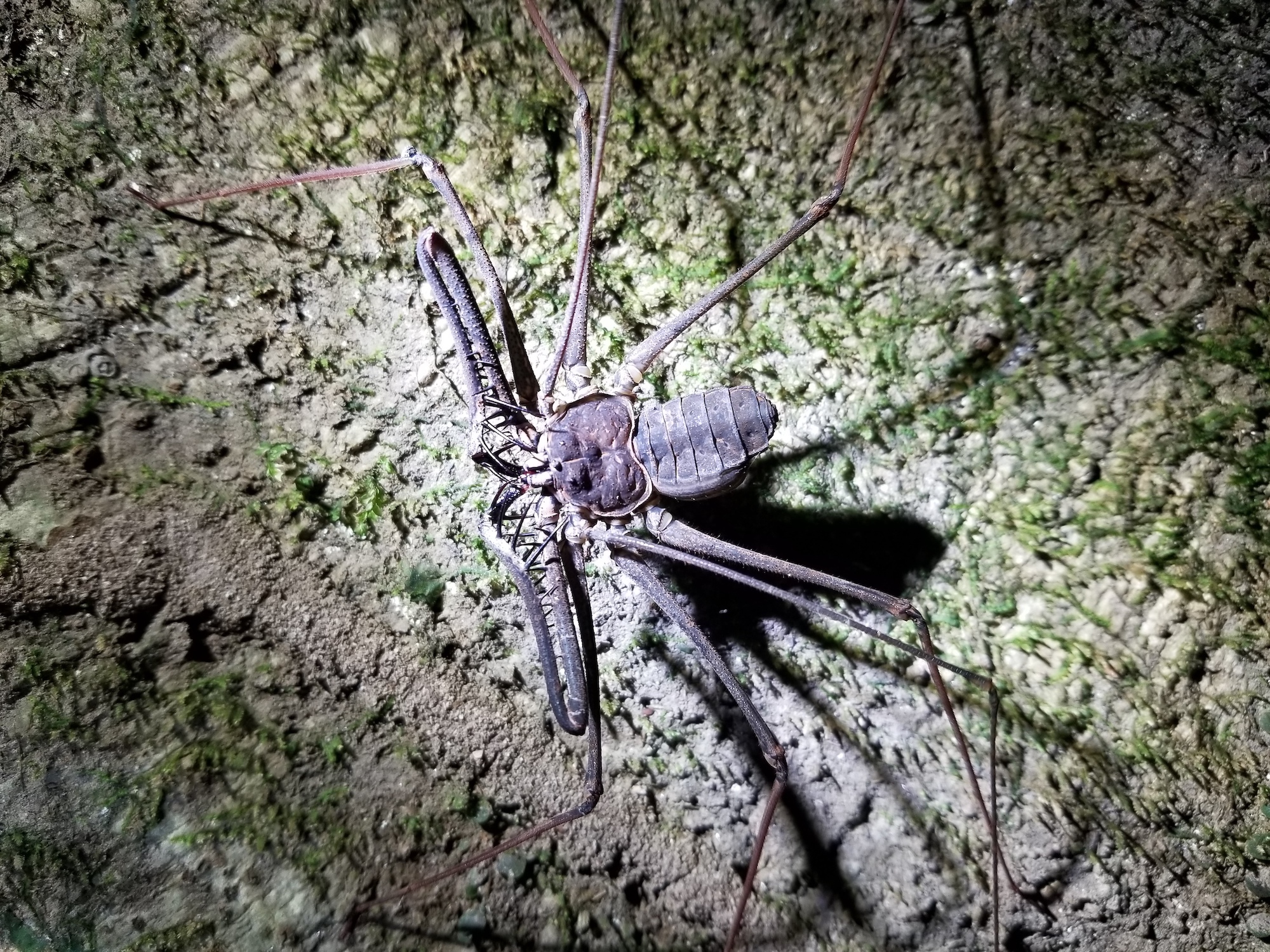
So the wildlife viewing from the two towers and on the ground has been very productive, but things are about to ramp up a notch as we next visit the clay licks and the macaw spring.
Parrots Galore
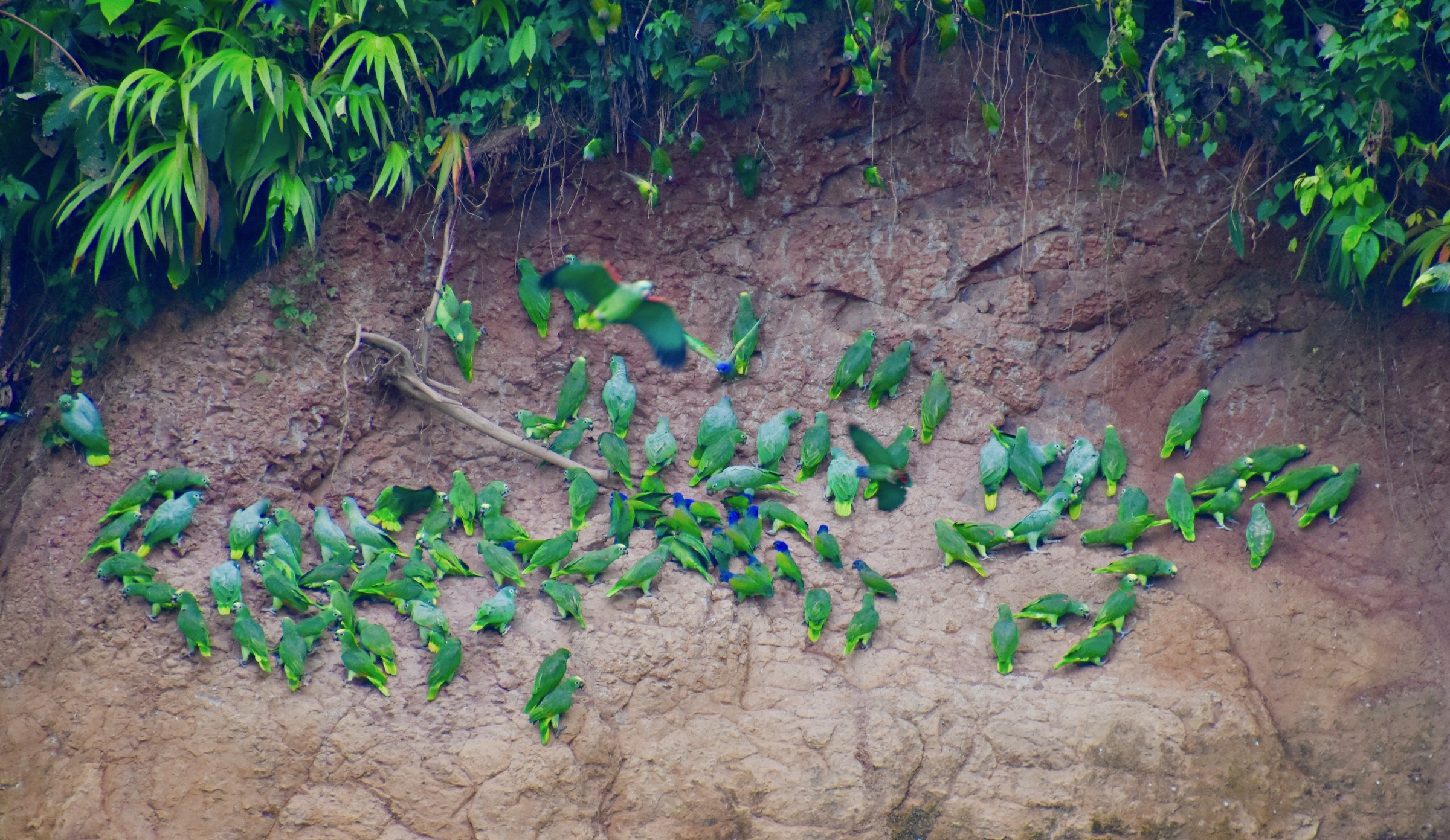
One of the reasons the Napo Cultural Center is located where it is is its proximity to a famous natural site known as a clay lick. No one knows why every morning like clockwork hundreds of blue-headed, mealy and yellow-crowned parrots along with two species of parakeet come to this spot to ingest clay. It was once thought that the clay acted as an antidote to toxins found in the nuts and fruits that make up their diet. However, the same species eating the same diet in other parts of the Amazon don’t indulge in this practice, so it remains a mystery.
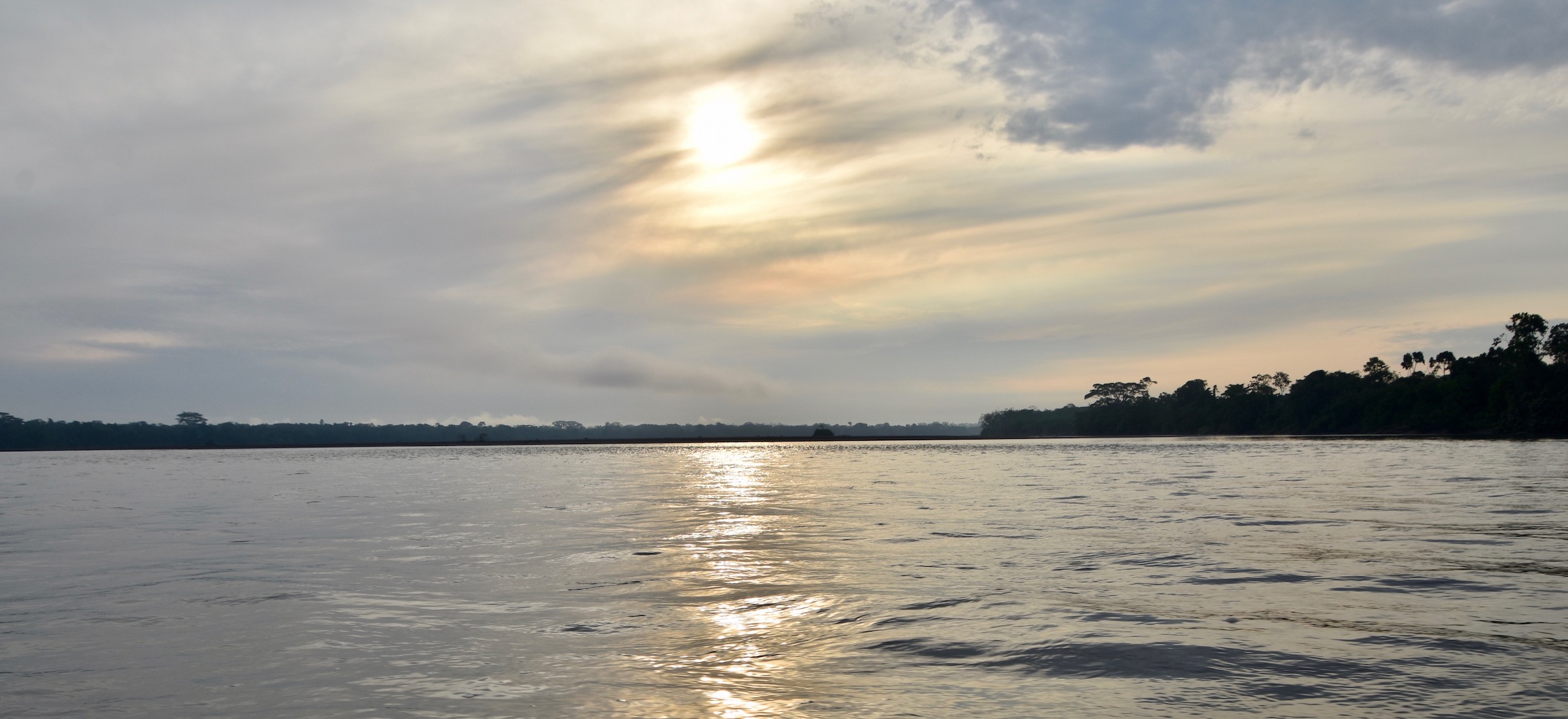
We get in the canoe at dawn and make our way downriver to a spot about 50 yards offshore so as not to interfere with this natural phenomenon. There are boats from other lodges here as well, but in no great numbers. Even though these clay licks are on the Napo Cultural Center territory, the Kichwa have no problems with visitors from other lodges as long as they observe the rule to stay well back from the banks.
Visiting a clay lick has been on my bucket list ever since I first saw film of one on a nature show many years ago. Now that I’m here it is almost hard to believe. The cacophony of the birds cries and the kaleidoscope of colours is something that has to be experienced to be believed. Below is a small gallery with photos I took from the boat. Double-click to see them full size.
- The Clay Licks
In the fifth photo the birds are scattering as they have been spooked by a boa constrictor that is hanging down from a tree and looks to me just like another branch, however, Sergio spots it right away as the cause of the panic. Despite their fear the birds keep returning and eventually one does succumb to the snake. I have photos of its demise, but you don’t want to see them.
Although our visit to this first clay lick ends on somewhat of a sombre note, I remind myself that what we observed was a completely natural event and that the boa has as much right to live as the parrots. Without natural predation some species would multiply to the point that they would all end up dying of starvation as they depleted their habitat of food. So while the snake was doing no favours to the one parrot he caught, he was not harming the species overall.
By around eight the parrots begin heading back to the forest and we head down river a little further where we disembark and begin a walk of well over a kilometre to the second clay lick.
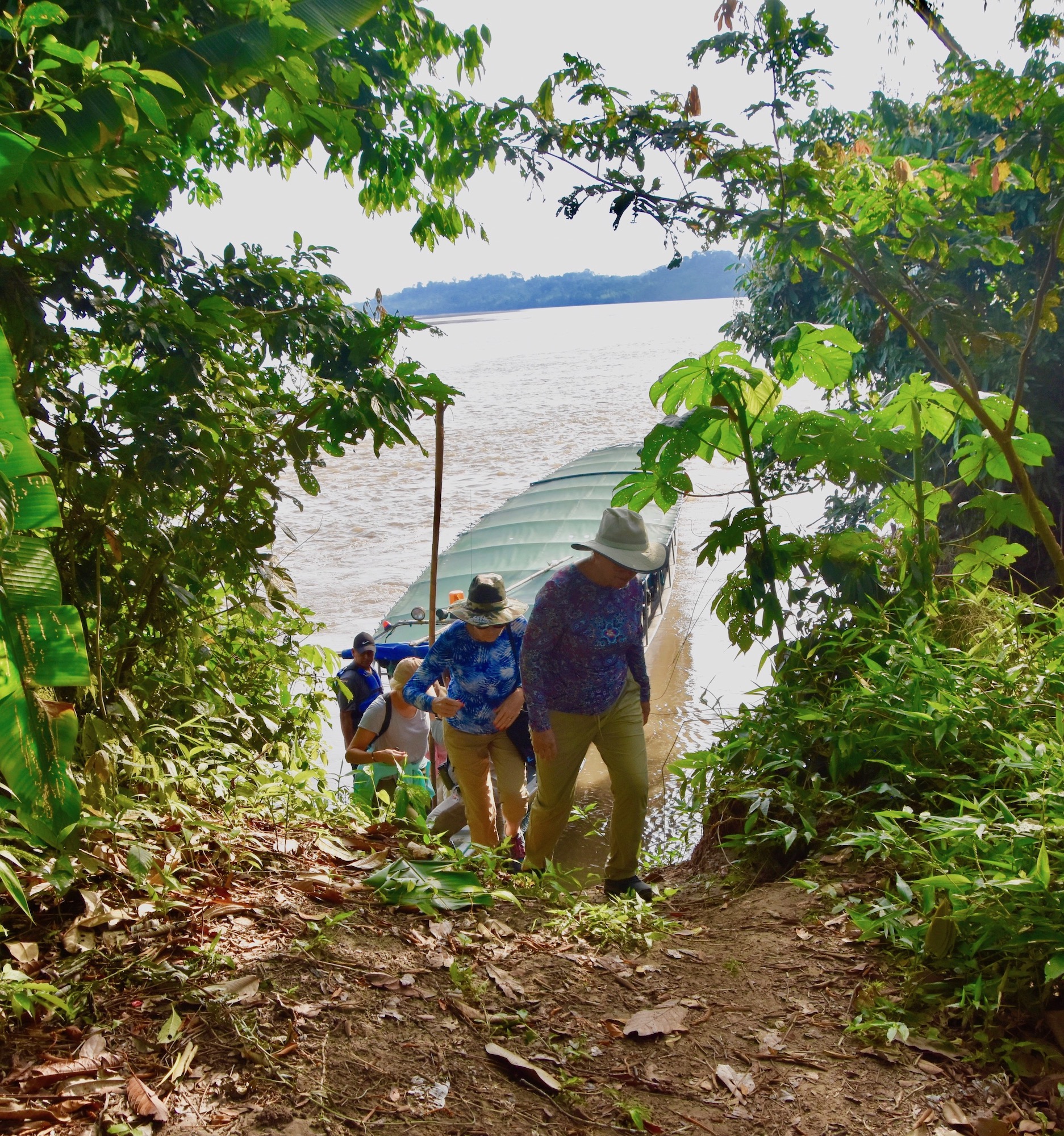
The Napo Cultural Center has created quite a different experience for the second clay lick. They have built a small viewing area almost like a mini-theatre with seating for about 30 people that overlooks a small spring that cascades down into a muddy pool. Here we are told many species of not only birds, but mammals as well come to drink or in the case of the parrots, ingest clay. We are also told that we must sit still and be quiet or else the wildlife will not make an appearance. And we do – for over an hour and I’m beginning to wonder if anything is going to show up today. Then there is a rustling in the trees and Sergio whispers “they’re here.”
Ever so slowly the birds, which from glimpses above we can see are scarlet macaws, come closer and closer to the ground.
- Macaw 1
- Macaw 2
- Macaw 3
- Macaw 4
Finally two birds are satisfied that the coast is clear and they land and start their business.
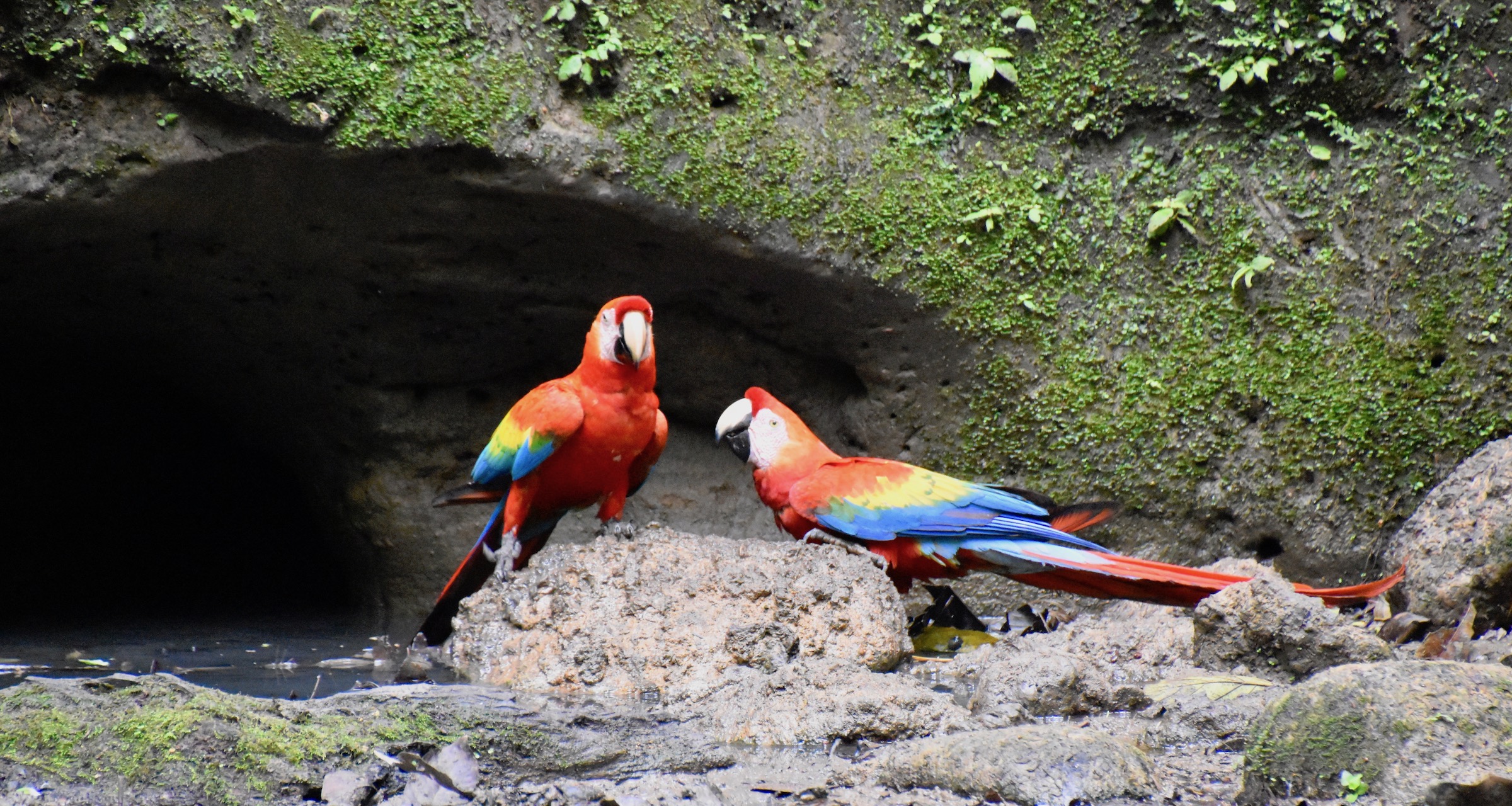
And soon there are half a dozen.
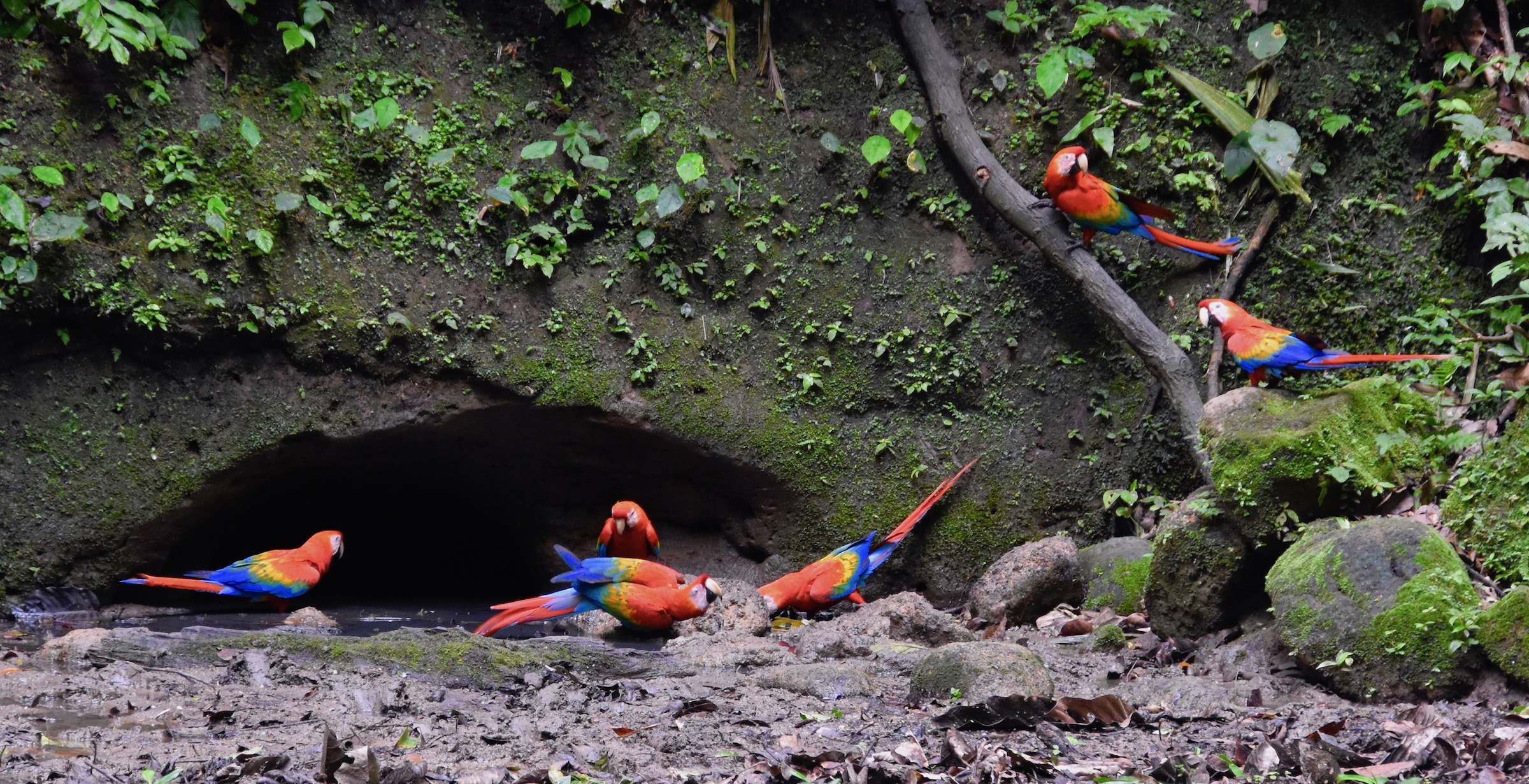
Not only are they eating clay and drinking water, but they are clearly socializing as well as they touch bills together and almost sound like they are talking to each other.
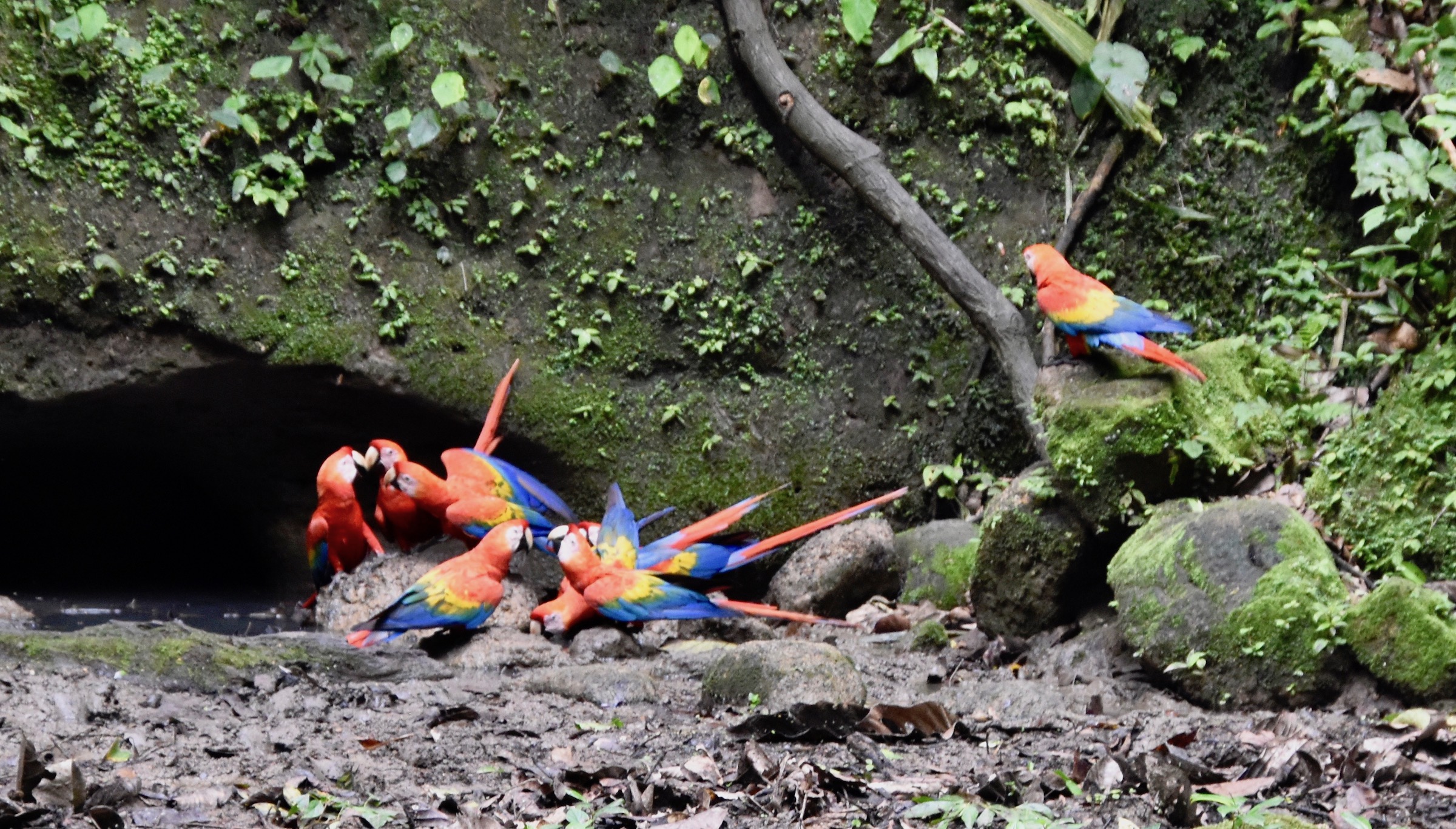
The macaws stay at the spring for about 30 minutes and just like that evaporate back into the dense jungle. Now we have all seen domesticated scarlet macaws in numerous places around the world, but to actually see them in the wild is another thing altogether. It is a sight I will never forget and the wait was more than worth it.
The wildlife viewing at the Napo Cultural Center so far has been exceptional and if that was it, anybody would be more than satisfied, but things are about to get amped up even more as we head up a small tributary of the Napo in search of some of the rarest animals on earth. Hop in.
The Canoe Trip at the Napo Cultural Center
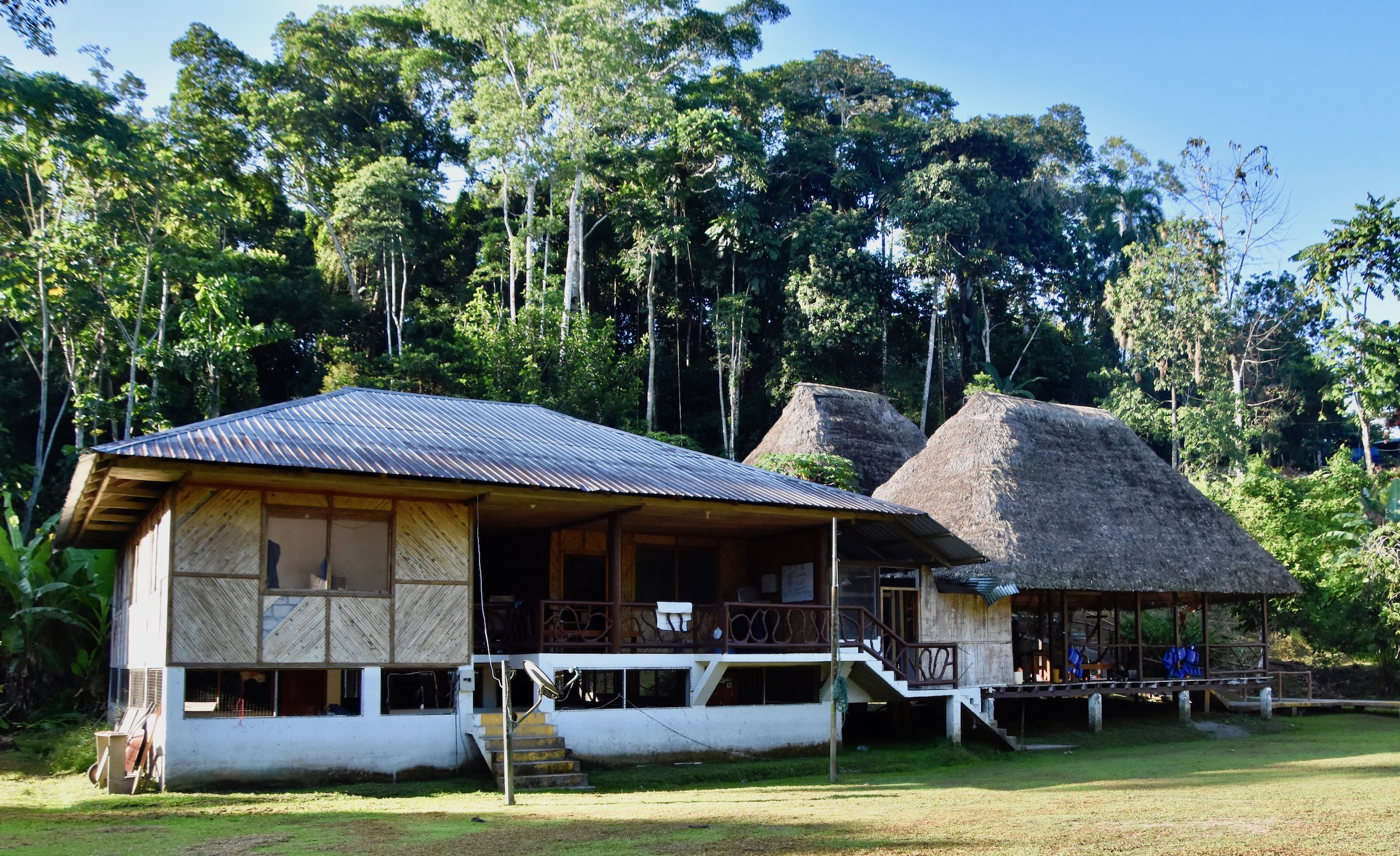
This is the Napo Cultural Center’s Welcome Lodge at the mouth of Anagu Creek. It is a fair distance from the main lodge and we arrive here in one of the large motorized canoes. From here we transfer into two much smaller and traditional canoes that each have two Kichwa paddlers and guides.
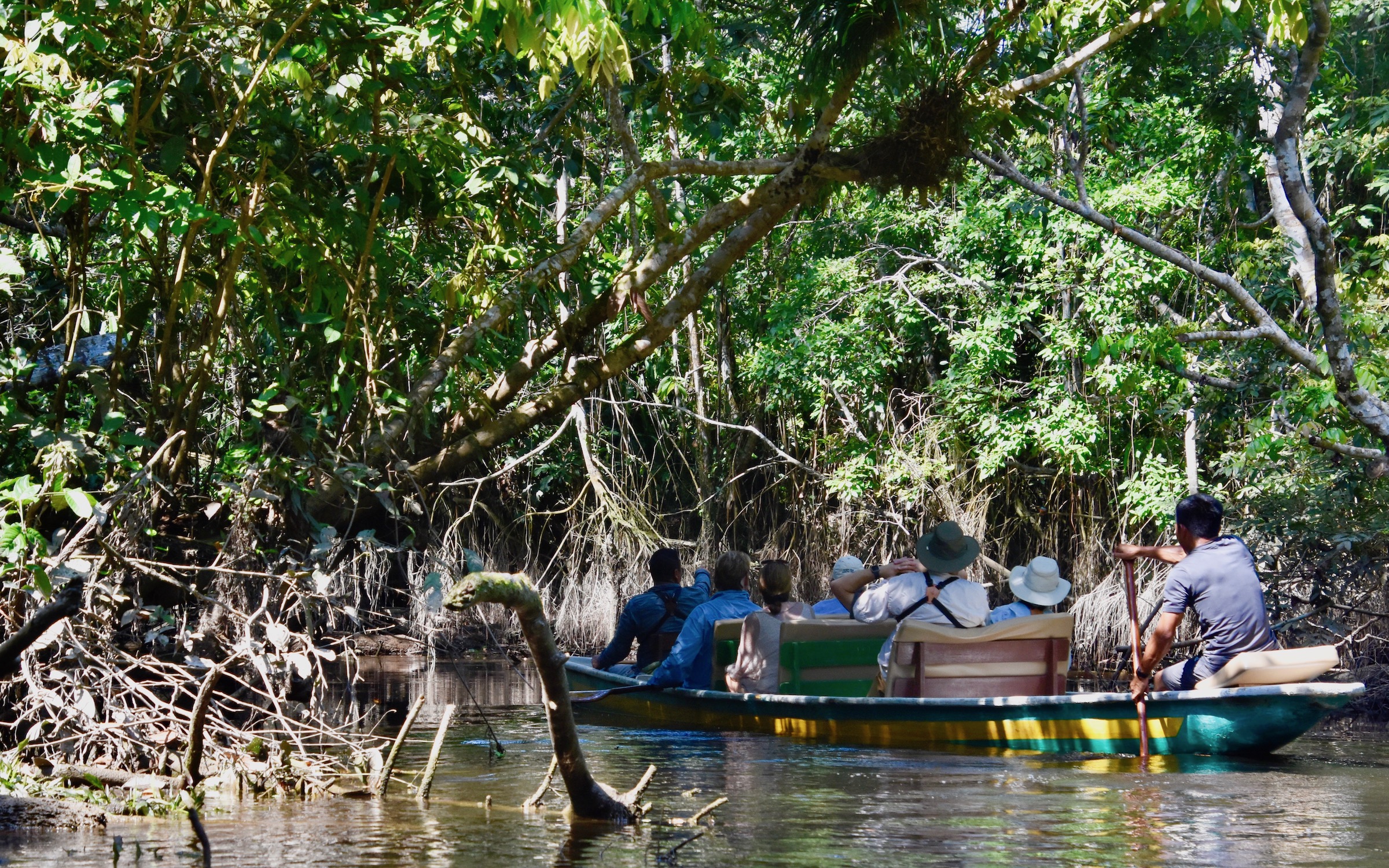
We are now going in search of giant river otters that at one time were quite widespread across Amazonia, but fur trappers and poachers have reduced the numbers in the wild to less than 5,000. Sergio tells us that there is a family that lives in Anangu Creek, but that finding them can be tricky and he is certainly not guaranteeing a sighting today. However, he reassures us that there is plenty of other wildlife to see and right off the bat we see this large bird which he identifies as a hoatzin. However, the Kichwa call it a ‘stinky turkey’, as the flesh is foul and they don’t hunt it. The hoatzin is one of the oldest birds in existence with fossil records going back millions of years. Some have compared it to archaeopteryx, the oldest known bird species as it has primitive claws on each wing as did that emergent avian species.
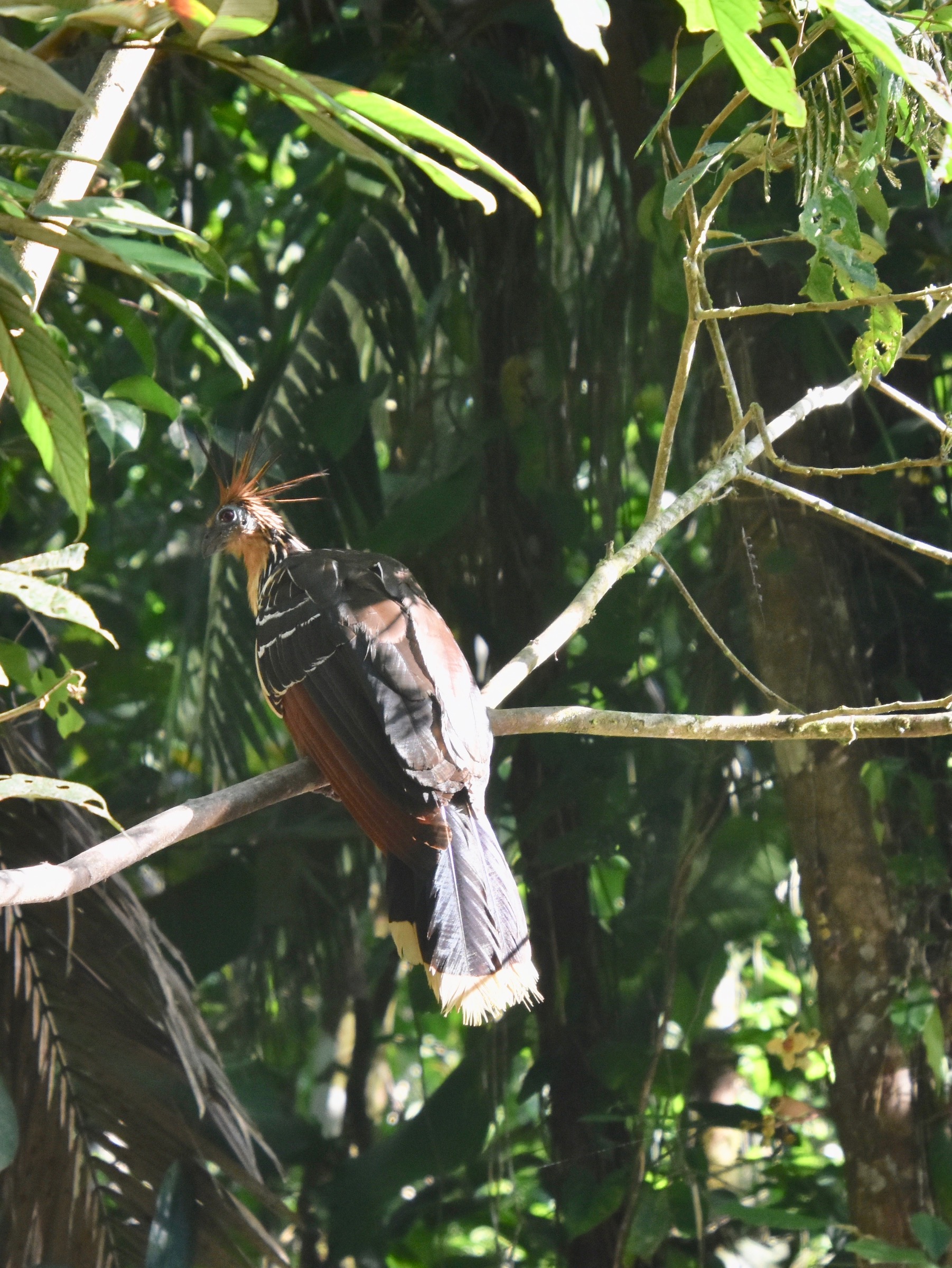
Other birds we see include a number of kingfishers including this ringed kingfisher which is yet another life-lister for me.
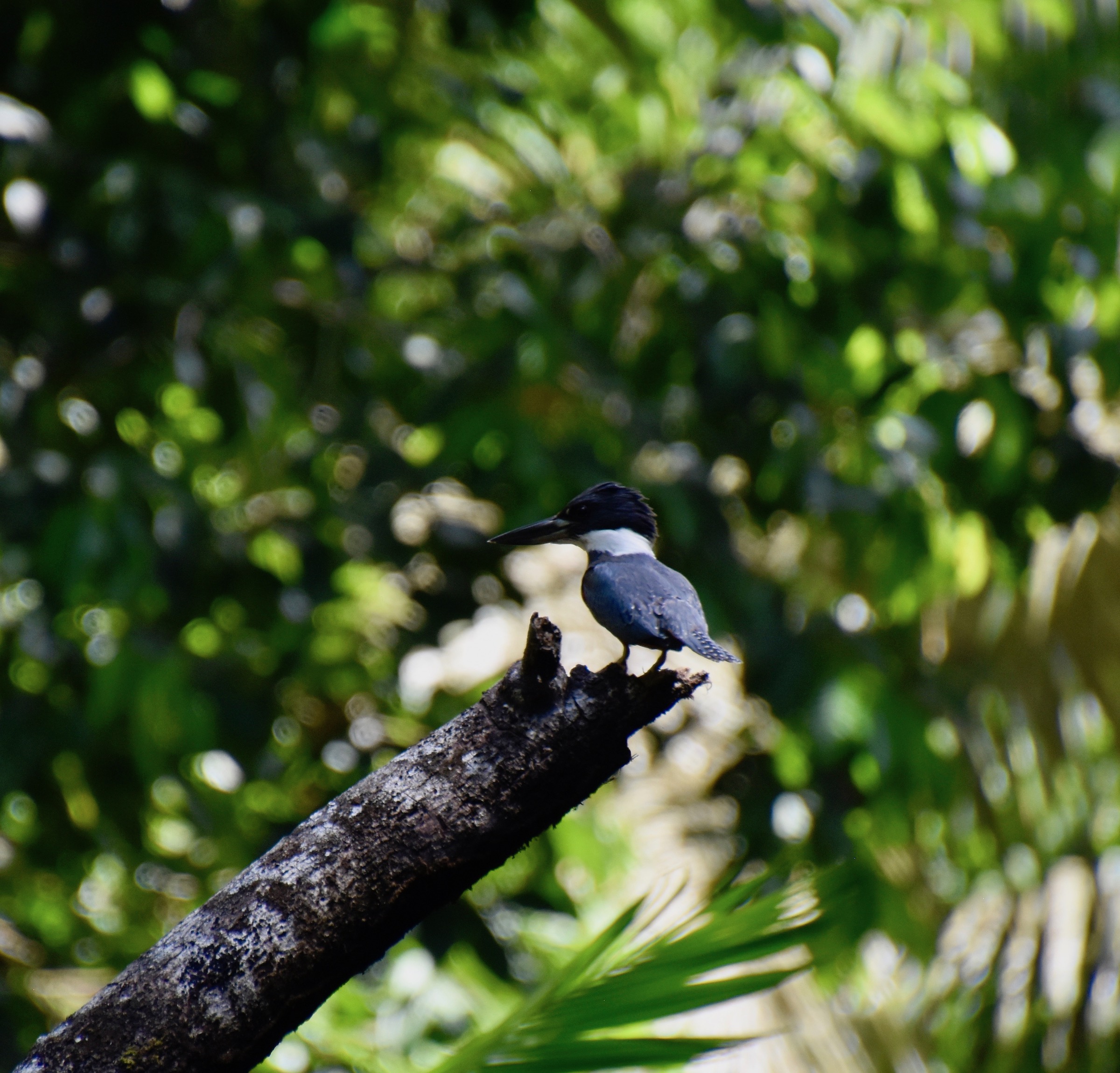
At one point Sergio stops the canoe and turns it around to look at what, at first glance, appears to be lichens on tree bark. Closer examination reveals them to be sleeping fishing bats.
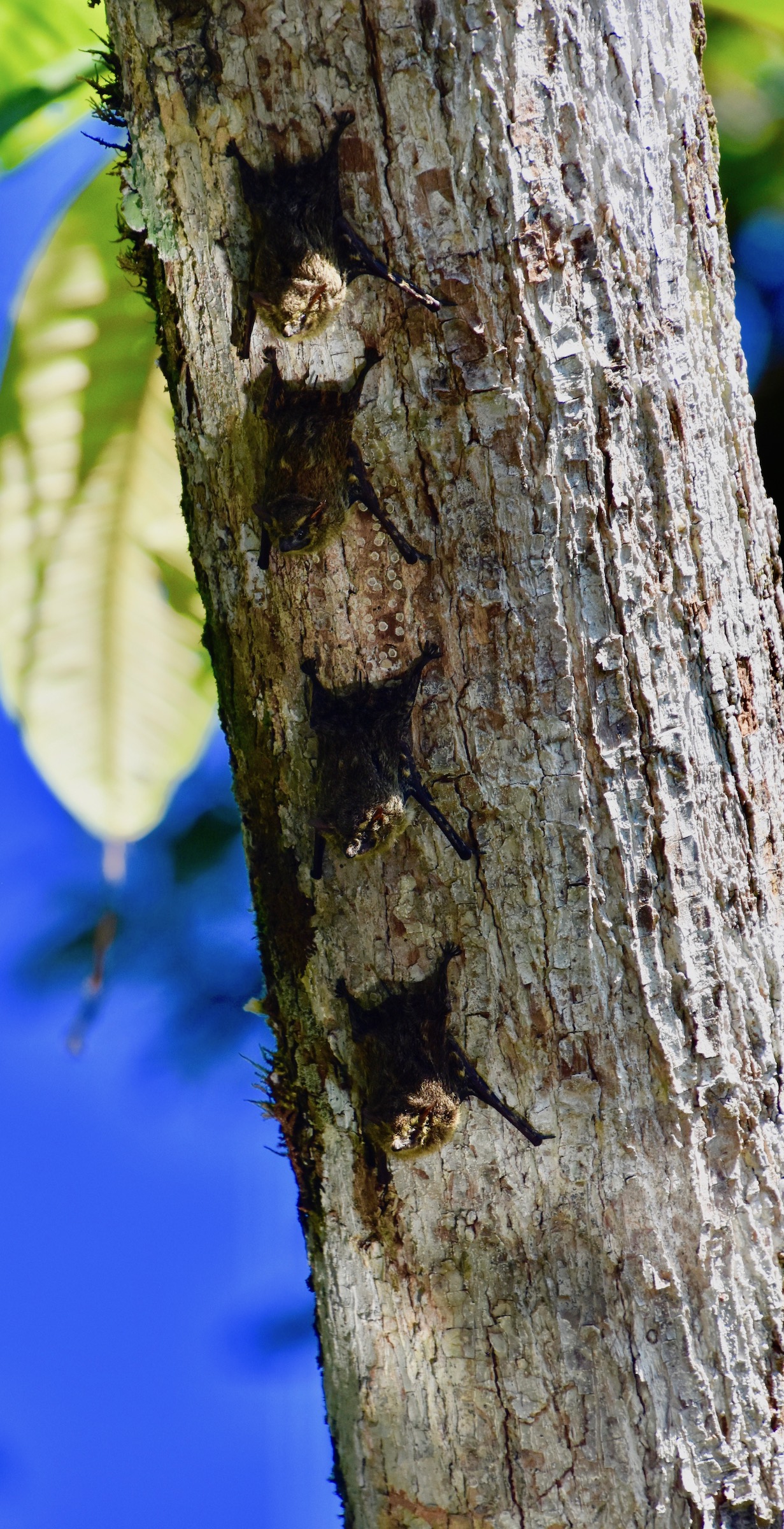
As difficult as it might be to detect the bats, it takes even sharper eyes to spot a black caiman lurking in the shadows. Now for some reason I had the misconception that caimans were among the smallest of the crocodilians and basically no threat to people like us passing by in a canoe. I was correct about all the caiman species except this one. While this caiman was not large, I later learned that it could grow as large as 20 feet and weigh 1,000 pounds (450 kg.). It is the apex predator of Amazonia and it eats whatever it wants including cattle, horses and freshwater dolphins. Sadly, like all crocodilians it was once hunted almost to extinction, but is now making a modest comeback. The Napo Cultural Center makes sure no caimans are hunted on their territory and thus the chance to see this rare species, albeit from a safe distance.
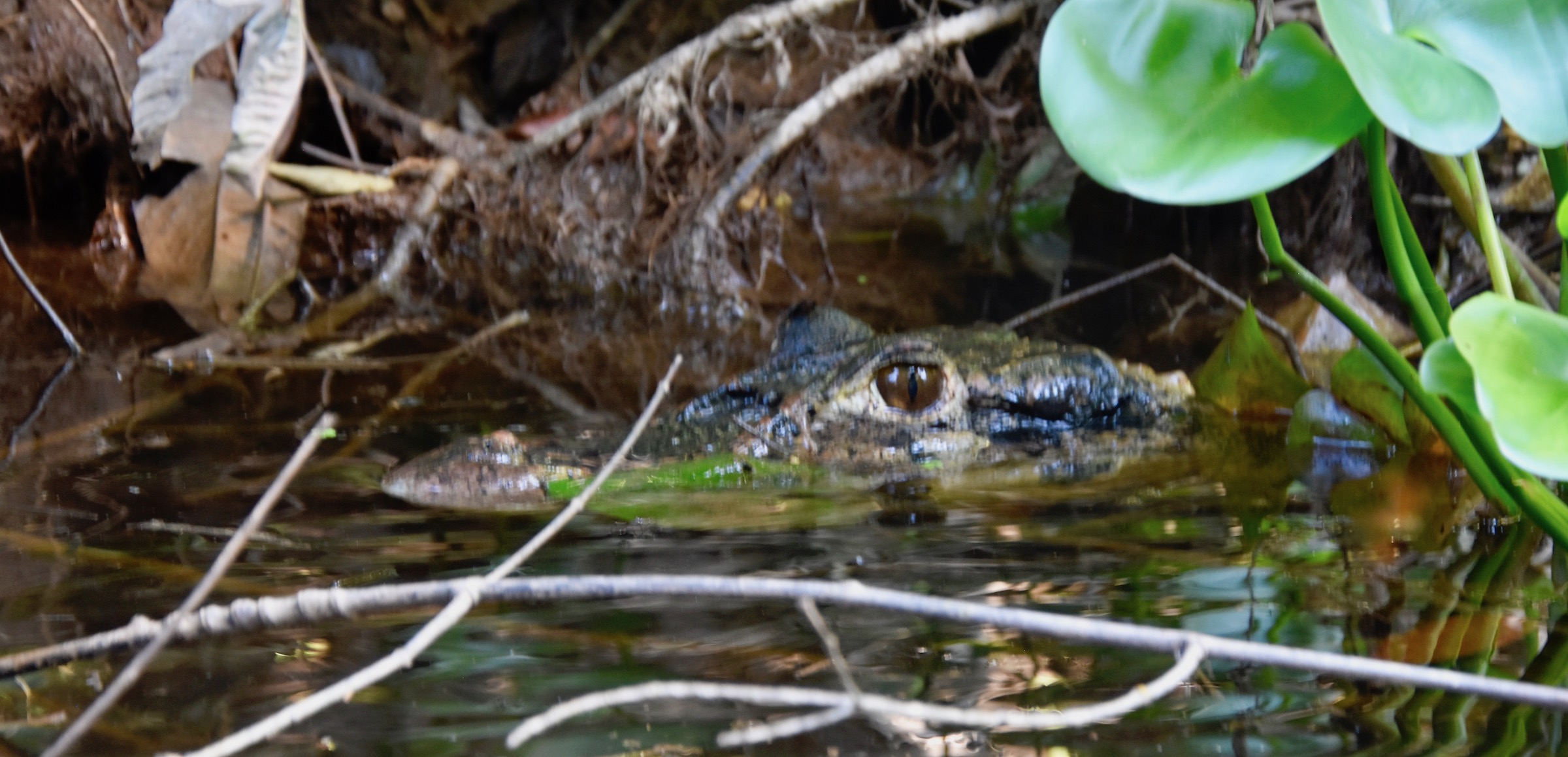
We had been going upriver for about an hour when Sergio beckoned with his hand for us to be quiet. We could then hear the distinct sounds of giant river otters close by. Moving ever so slowly we gradually rounded a bend and there they were – a family of six giant river otters. They were a magnificent sight and we observed them both catching and munching down fish and clearly indulging in play with each other. This is a gallery of photos I took that day. Double-click to enlarge.
- Giant River Otter Close Up
- River Otter Eye to Eye
- Giant River Otter
- Three Giant River Otters Spy Us
- Three River Otters Flee
I’ve seen otters a number of times in Canada including a family we occasionally see in a creek not far from where we live, but I’ve never been this close to them on the water. The canoe trip has been an unqualified success and it is time to head back to the Napo Cultural Center.
We are almost back to where we started when something close to miraculous happens. Out of the blue a massive bird flies right overhead and lands not fifty feet from the canoe. Being a life long birder I immediately recognize it as a harpy eagle, the most powerful raptor on earth and a living terror to the monkeys and sloths of Amazonia. Although widespread throughout Central and South America in terms of range it is exceedingly rare in any one place. I do manage to get some decent photos including this one.
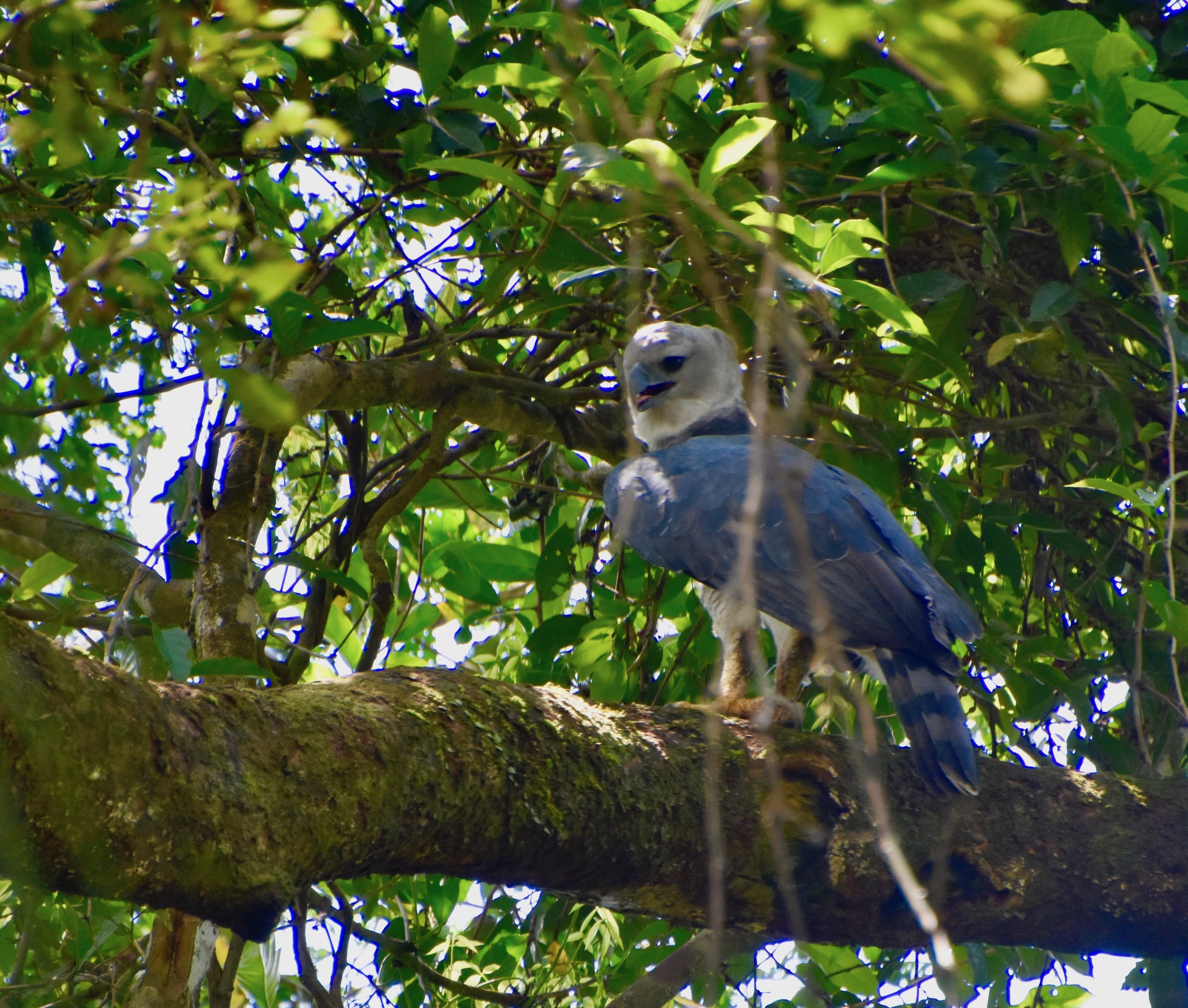
When I say this was a miraculous sighting I meant it. Although others at the Napo Cultural Center were initially skeptical that it was a harpy eagle because no one had seen one in the area for five years, when they looked at my photos they were convinced it was in fact a harpy eagle. The Napo Cultural Center Facebook photo page now features this and another photo. So purely through serendipity I managed to see one of the most magnificent birds in the world as the frosting on the fantastic cake that was served up on this magical trip to Amazonia.
Our final meal at the Napo Cultural Center included deep fried rhinoceros beetle grubs which were actually very good and apparently nutritious as well. While I declined to eat the live ones offered (as did everybody else) a few of us ate the cooked ones and didn’t regret it after.
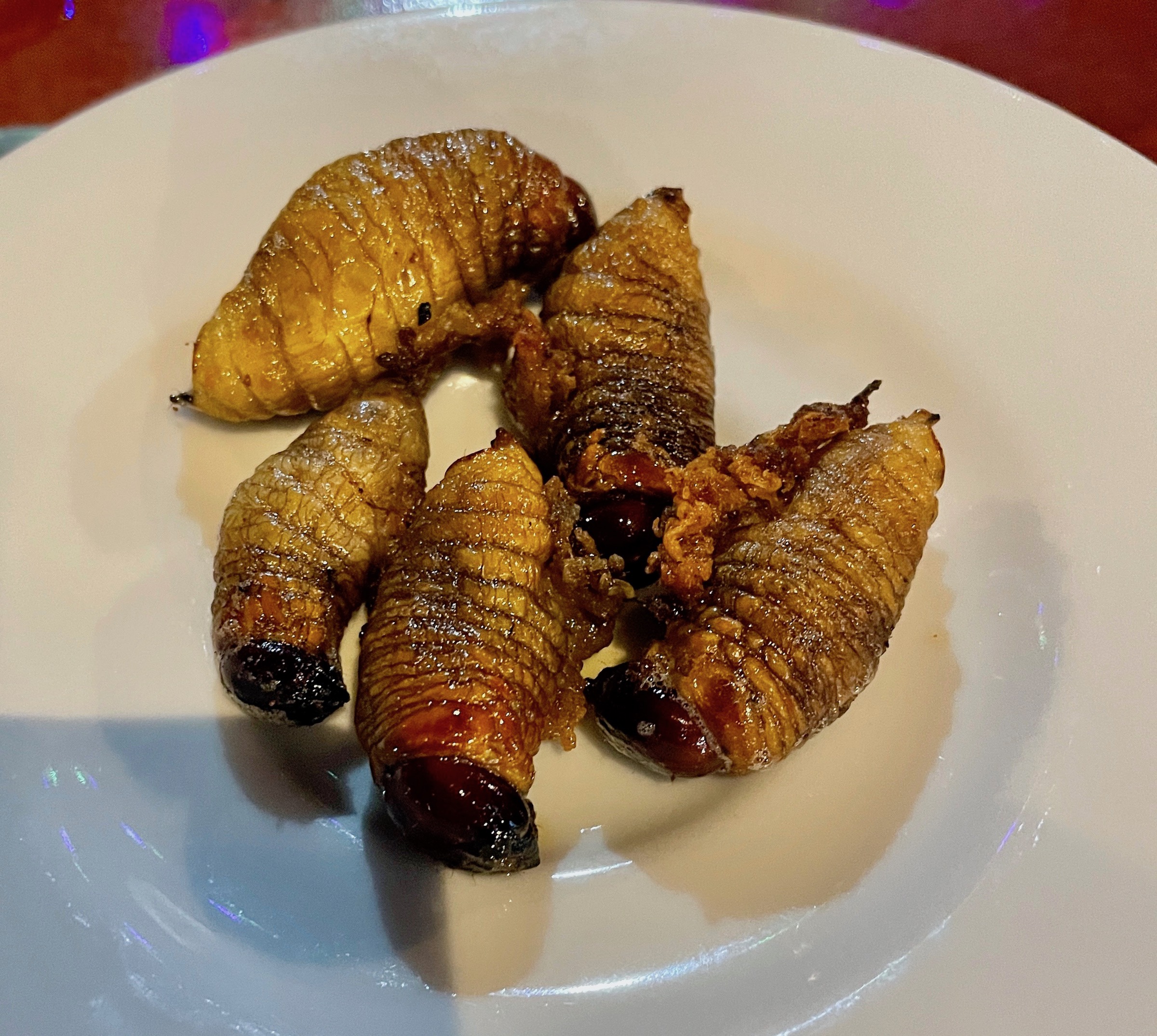
On that gustatory note, that ends my posts from the Adventures Abroad portion of the Ecuador trip. However, Alison and I will be journeying on with our own private guide to the Route of the Volcanoes. Please join us.


